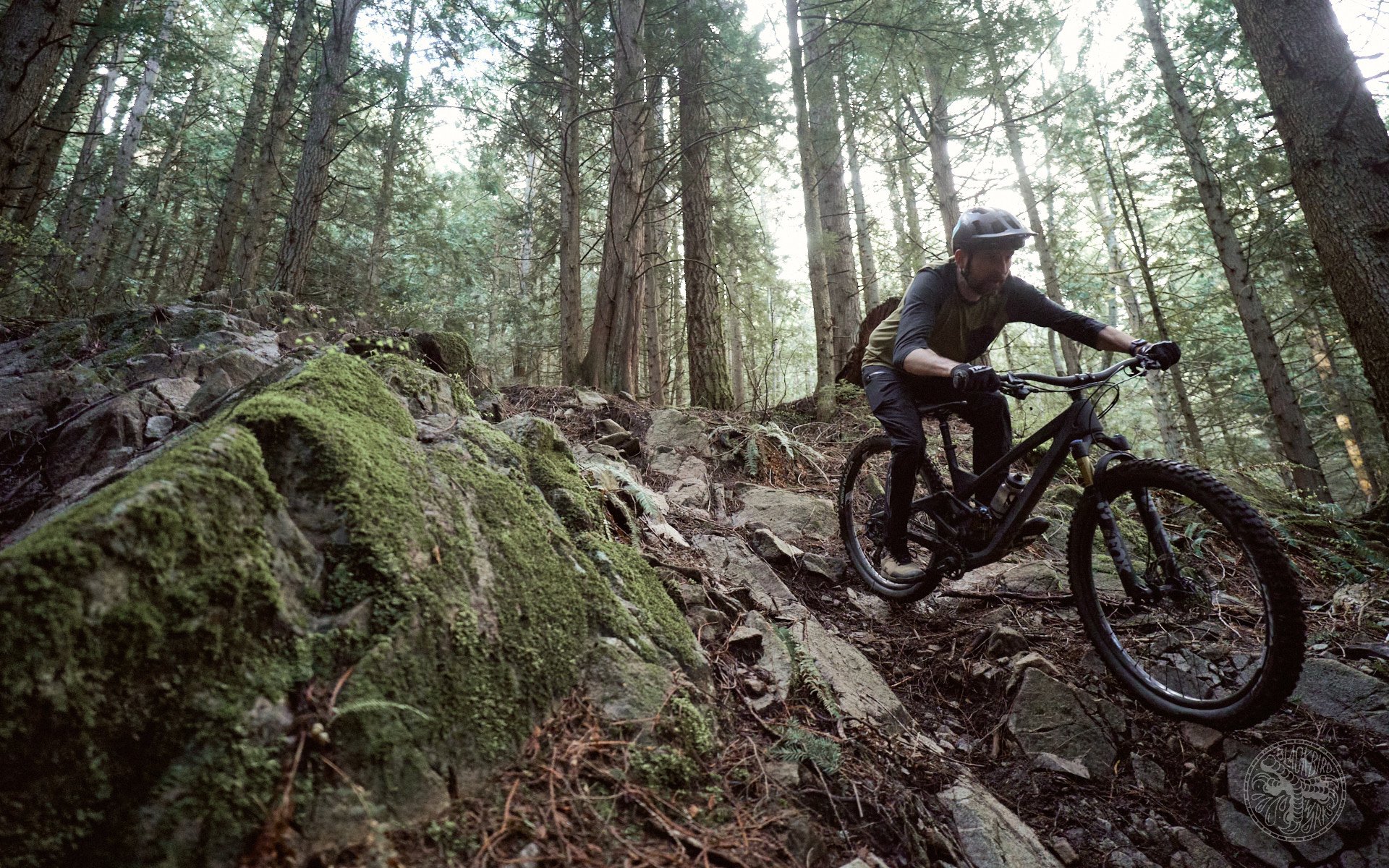
Built in Kamloops
We Are One Arrival - Long Term Review
Perhaps this is arguable, but I believe We Are One has one of the best stories in mountain biking. What other company was founded by a world cup DH racer?* What other company has put more energy into making so much in house? What other company started with in house carbon fiber manufacturing? What other company packs a verb in their name?
This story seems so good, in fact, that we’ve told it a few times here at NSMB. There was a press release. Cam did a first look at the Arrival. There’s a video about the launch of the Arrival. There’s even an older interview with Dustin Adams. And shit…even more (here and here)! With all of those at your disposal, we can worry less about the bigger picture and hone in on this specific bicycle: The We Are One Arrival with the SP2 build kit in an SZ3 frame size.
*Other than Unno…Tomac…maybe Atherton…probably a couple others that I missed.
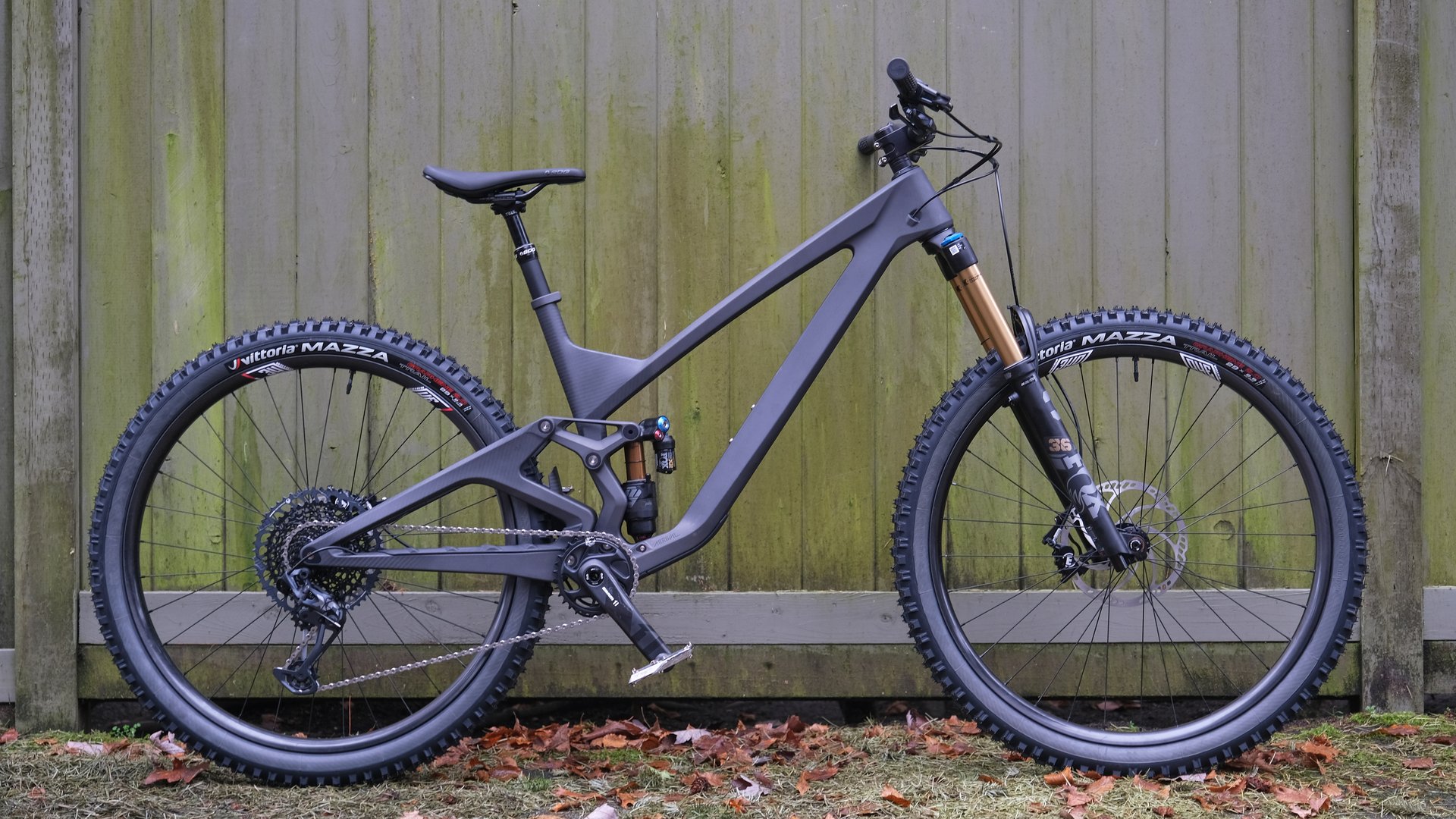
The Arrival. Like a stealthy little battleship.
Let’s talk aesthetics
This thing could ride down the hill like a turd caught in a rockslide, and it might not even matter. It just looks that good. I was out riding last week and I caught sight of one in the wild and I ran over excitedly and started asking the guy questions about it…all the while having one of my own (temporarily) that I could spend any amount of my free time looking at. I just wasn’t used to seeing it from that angle and got really excited! It’s that striking.
Part of this is just the brazen, unapologetic use of carbon fiber, and the Cerakote paint that seems to shrug off wear and scratches. I love both of these things, but I also wonder what this thing would look like without the cosmetic weave, and with no paint? I’d sort of love to see a full stealth frame with the same finish as the rims. I did ask the question as to why they went in this direction with the frame. “It's fun to show just how nice carbon can look” was the response I got. Fair enough.
Speaking of stealth, it’s interesting to see the decisions We Are One has made with their branding. Those that know, know, I guess. Though, anybody not on top of the latest in bicycle technology might be confused by what they are seeing. I had countless trailside conversations about this bicycle, and more than a few resulted in blank stares and uncertain head nodding when I explained who made this shadow of a bicycle and where it came from. It’s a bold move to not put your brand name on the first bicycle that you ever created. I’m not saying they should slap that shit all over the thing (it is a bit of a mouthful), but a nice little head tube badge wouldn’t be so bad.
No matter. Whatever they’ve done, it looks good, and it’s definitely different.
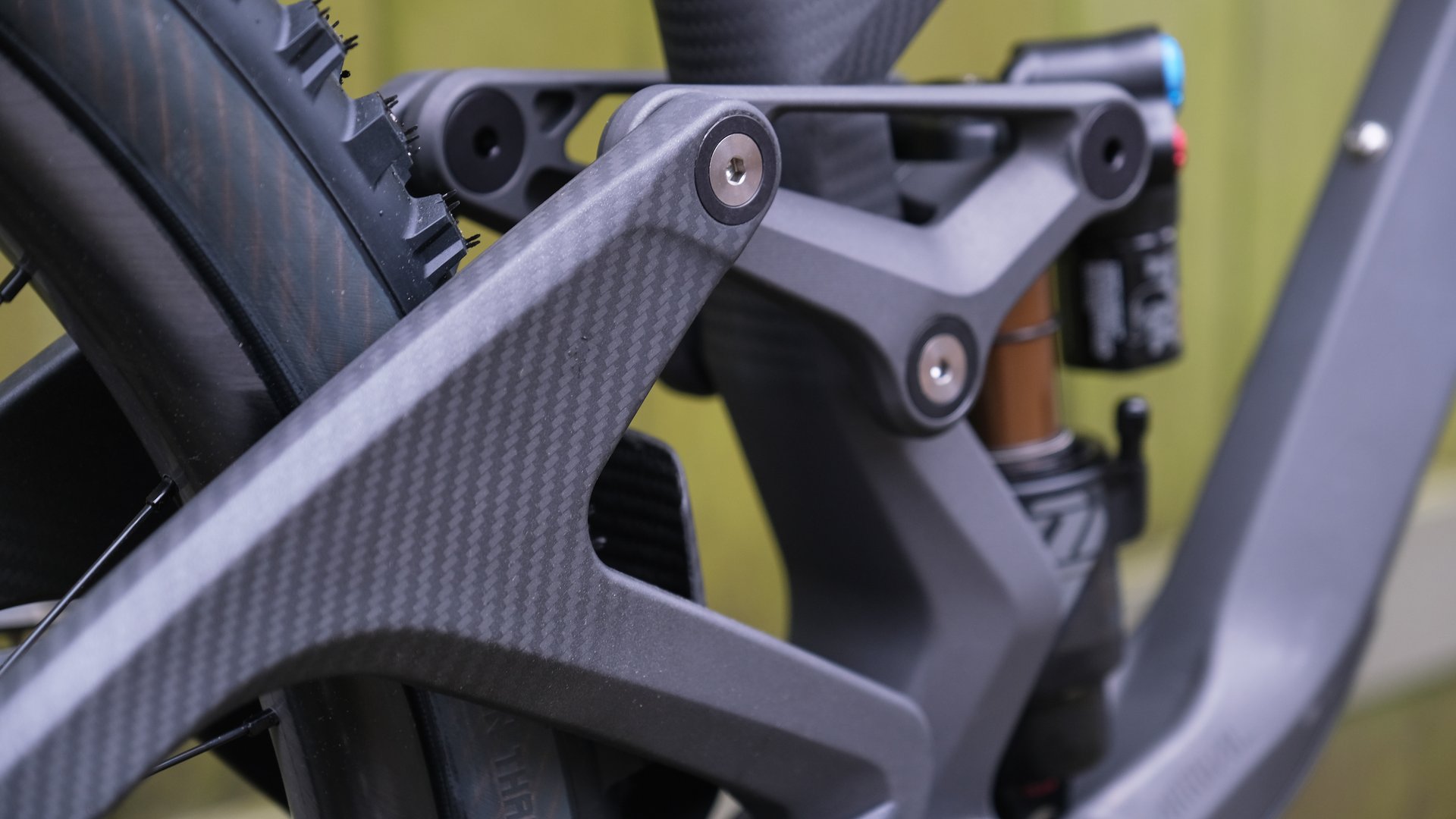
We're just going to take a minute to appreciate some of the finer details, like the nicely machined link here.
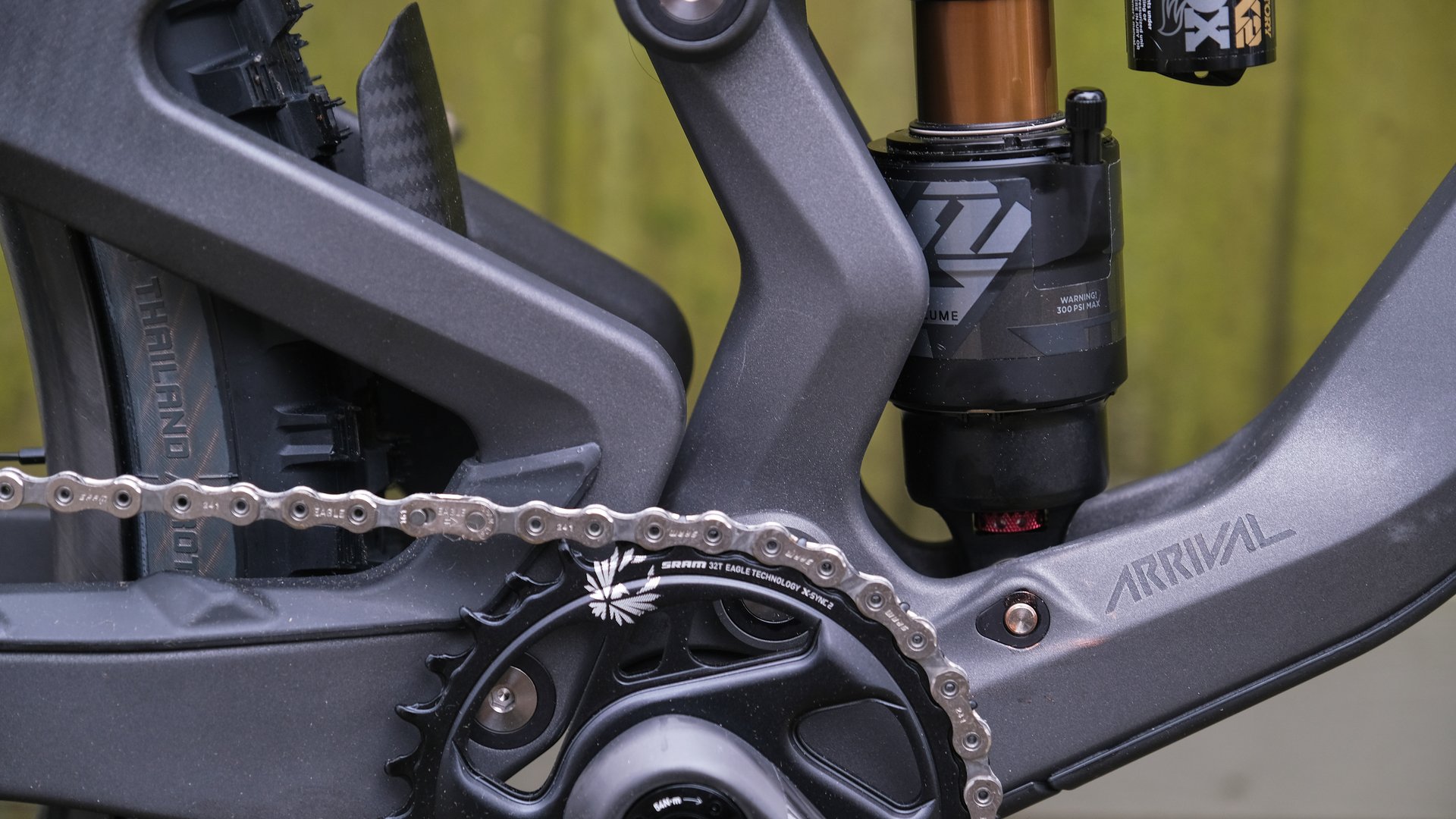
And the subtlest of...shit...not even branding, here.
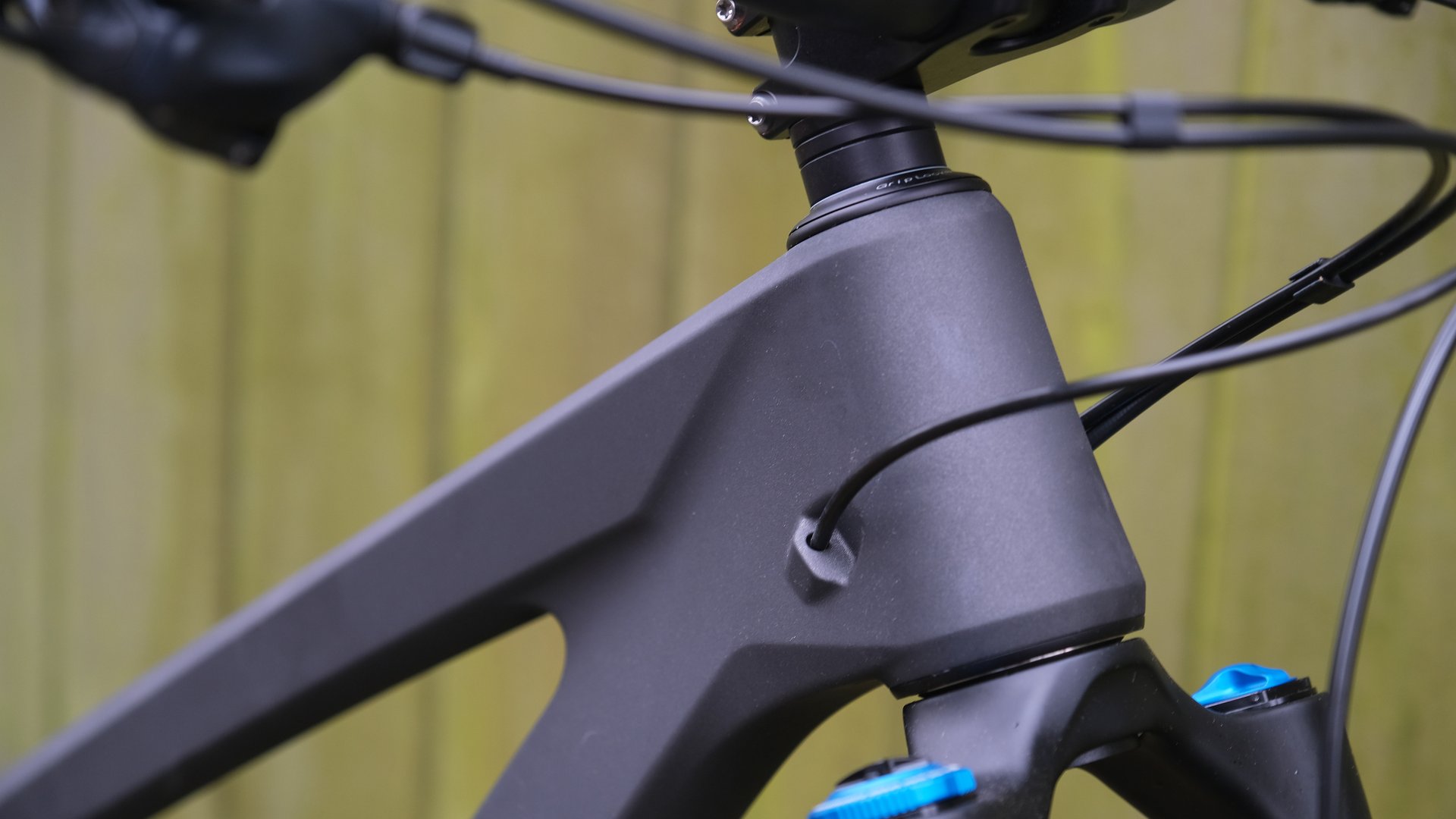
The cleanest head tube, ever.
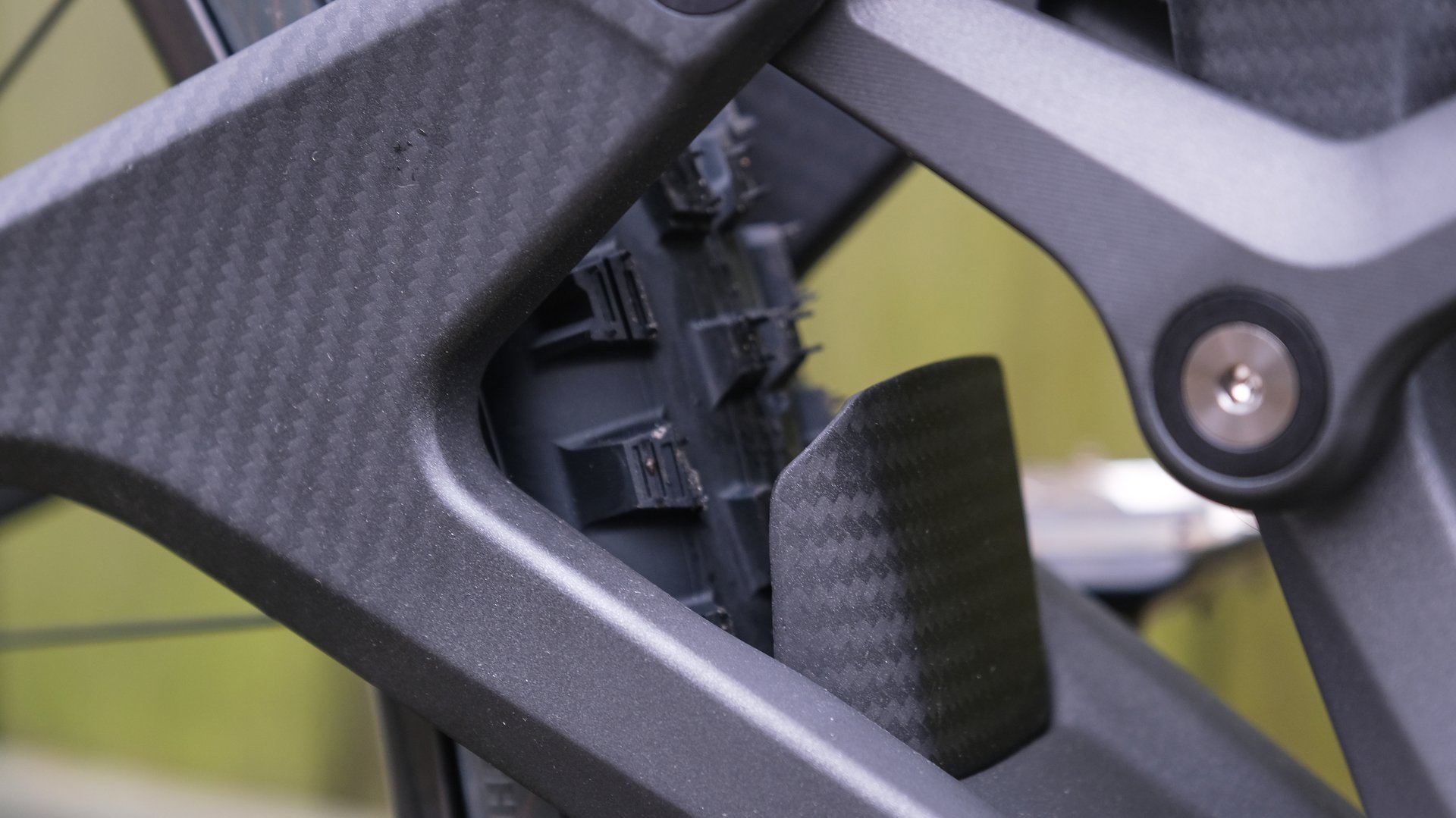
And a nice little fender.
The Suspension
Moving along to some of what will determine how this thing actually makes its way down a mountain, let’s have a look at the suspension. What we don’t have are any graphs showing the kinematics. What we can do though, is draw some of our own conclusions.
The first conclusion that we can draw is that this is a fairly high leverage beast. 152mm of travel out of a 55mm shock is certainly something I would describe as “high leverage.” I find higher leverage bikes always take a little bit more time to get sorted, as it can feel strange to keep ramping those pressures up and up. You also need greater jumps to feel a dramatic difference.
Drawing some simple lines we can get an idea of what is happening with the instant center. It starts quite a bit higher and in front of the top of the chainring, and then swings down before winding up at around the top of the chainring. This suggests a sizeable helping of anti-squat at sag, which will drop off somewhat as the bike goes through its travel. There’s also enough progression in the rear that We Are One feels confident in selling a coil shock option.
At this point, we’ll head on over and take a look at some of the quotes provided by We Are One on these topics.
The main goal with the design, kinematics and the geometry was to create a very stable and predictable system, which allows the rider to push their limits confidently in any type of condition and terrain.
Starting with the geometry, the first step was to get that stable 'in the bike' feel instead of the 'on the bike.' Having 75-85mm bottom bracket drop and head angle of around 63 deg, at sag with the rider on, allowed dropping the centre of gravity of the whole bike/rider combo by up to 20mm compared to other enduro bikes in the same class. This removed the need to have excessively long front and rear centre of the bike, which is a common and easy way of increasing overall stability of the bike.
The goal with the kinematics was to create a platform, around the sag zone, which keeps the bike high in its travel and stays super responsive to rider inputs. Having reduced sag amount of 22-25% (38-44mm) at the rear wheel allowed the Arrival to have a similar initial behaviour to a shorter travel bike. That 'wakes up' the bike a lot on low speed an low intensity trails, and the rider could use way less energy pushing and pulling in order to gain or preserve momentum.
Both the anti squat and the anti rise values are set up to aggressively preserve geometry in that sag +-20mm zone.
The leverage ratio starts high at 3.4 and drops to 2.95 at sag, which allows the Arrival to be extremely supple off the top, even when set up with air shocks.
For the remainder of the rear travel - sag to bottom out - the leverage ratio preserves the progressive behaviour, but only drops down by another 0.5, down to 2.45, when fully compressed.
The anti squat and pedal kickback are reduced aggressively throughout the rest of the travel, having little to no effect on the suspension in the last 40% of the travel.
Anti rise values are pretty constant - 95% at sag, and falling down to 80% at full bottom out, which provides a very consistent and predictable braking feel throughout the whole travel range.
The front to back centre ratio starts out at 1.87, then 1.83 in the sag area, and ends at 1.77 at full bottom out. The rider's confidence comes with consistent and predictable grip, so having a constant front to back weight distribution throughout the whole travel allows the rider to stay in their desired position, without trying to compensate for any excessive shifts.
Without seeing the curves, it’s hard to see exactly what is going on, but what We Are One describes sounds in the same ballpark as what one might experience with an Ibis Ripmo, or other dual link/DW-Link bike, albeit with curves designed around lower sag values. From our line drawing exercise above, we can see why this is the case. Pivot locations and linkage lengths of course mean that there will be as many differences as similarities, but if one wanted to imagine the shape of the curves of the Arrival, one could do worse than to start with the curves that are shown here to gain an understanding of what is happening. Stress on the word shape. Actual values, locations and slopes will vary.
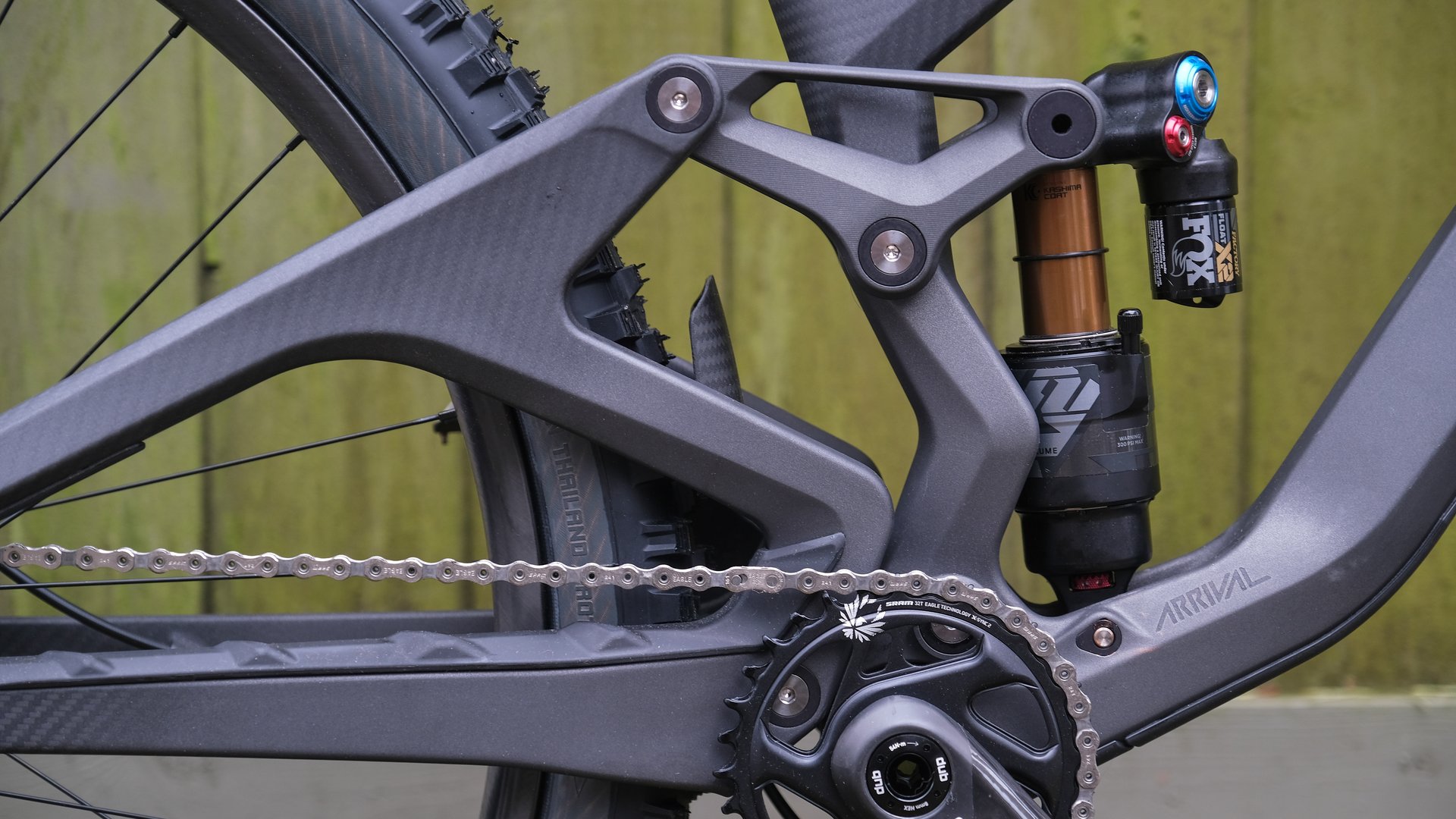
Draw some imaginary lines through those pivots and you can picture what is happening with the instant center.
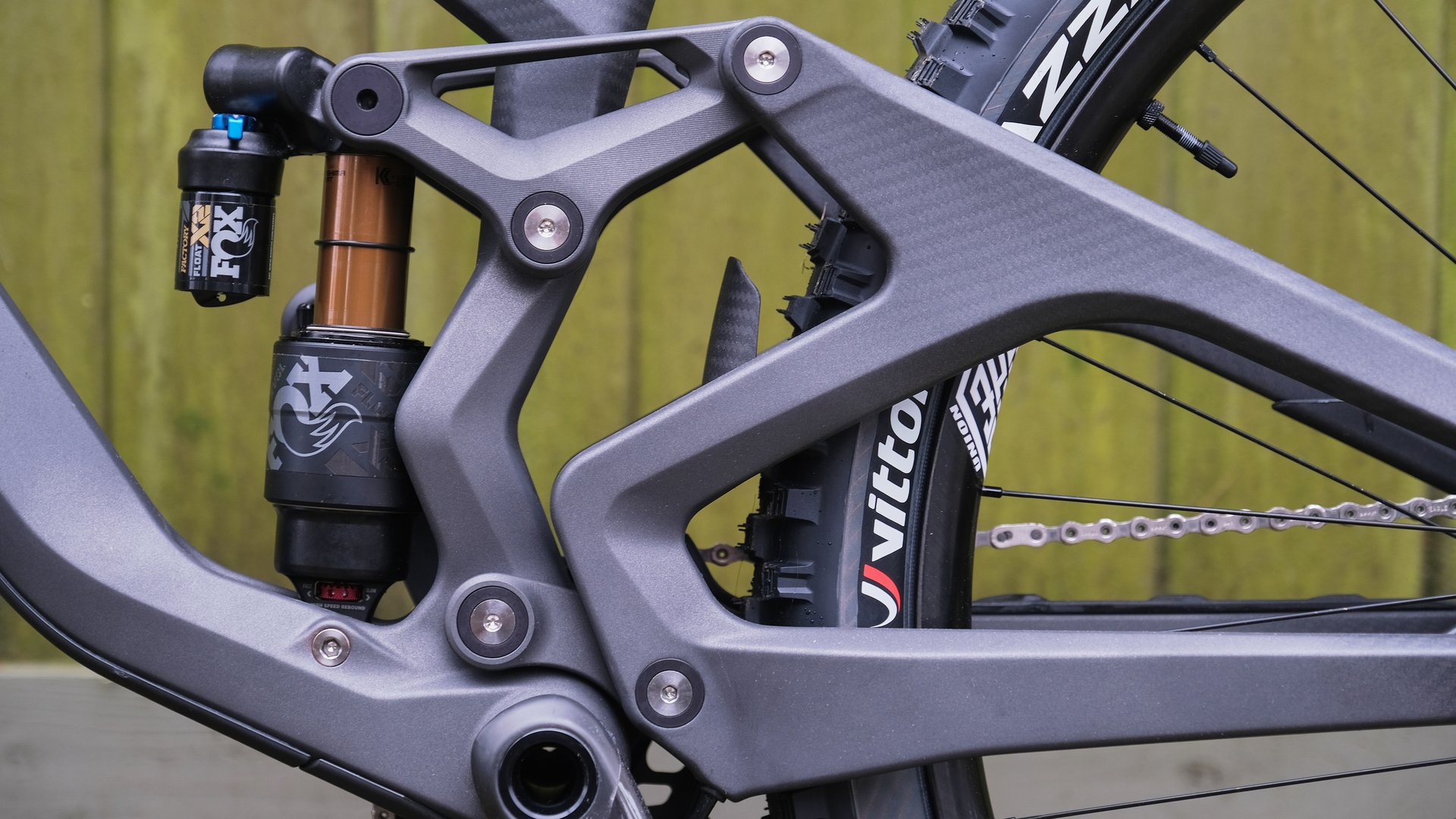
The non drive side gives you a bit more of an idea as to what is happening.
Fit and Sizing
This frame is the largest that We Are One offers, the SZ3. Again, visit the launch article to compare between sizes, but this one here is as follows:
Reach - 500mm
Stack - 626mm
Headtube length - 105mm
Chainstay Length - 441mm
Headtube Angle - 64 deg
Front Center - 836mm
Wheelbase - 1277mm
Seat tube angle - 77deg
BB drop - 37mm
BB height - 338mm
Effective top tube length - 645.5mm
Fork offset - 44mm
Standover - 676mm
The 500mm reach made this an easy call for me to go with the largest frame size. Hopping on board though, this thing felt a lot longer than the numbers would indicate. On paper, it’s not that far from the XL Ibis Ripmo AF (495mm reach, 642mm stack) or even the XL Santa Cruz Megatower (495mm reach, 656mm stack), but this bike feels longer. I think this is down to the low stack height rather than the reach number. Maxing out spacers helped, but if this bike was going to hang around for the long term, I’d start playing around with some higher rise bars.
The SZ3 also gets slightly longer chainstays than the other two sizes, although the growth in length isn’t major (from 437mm up to 441mm).
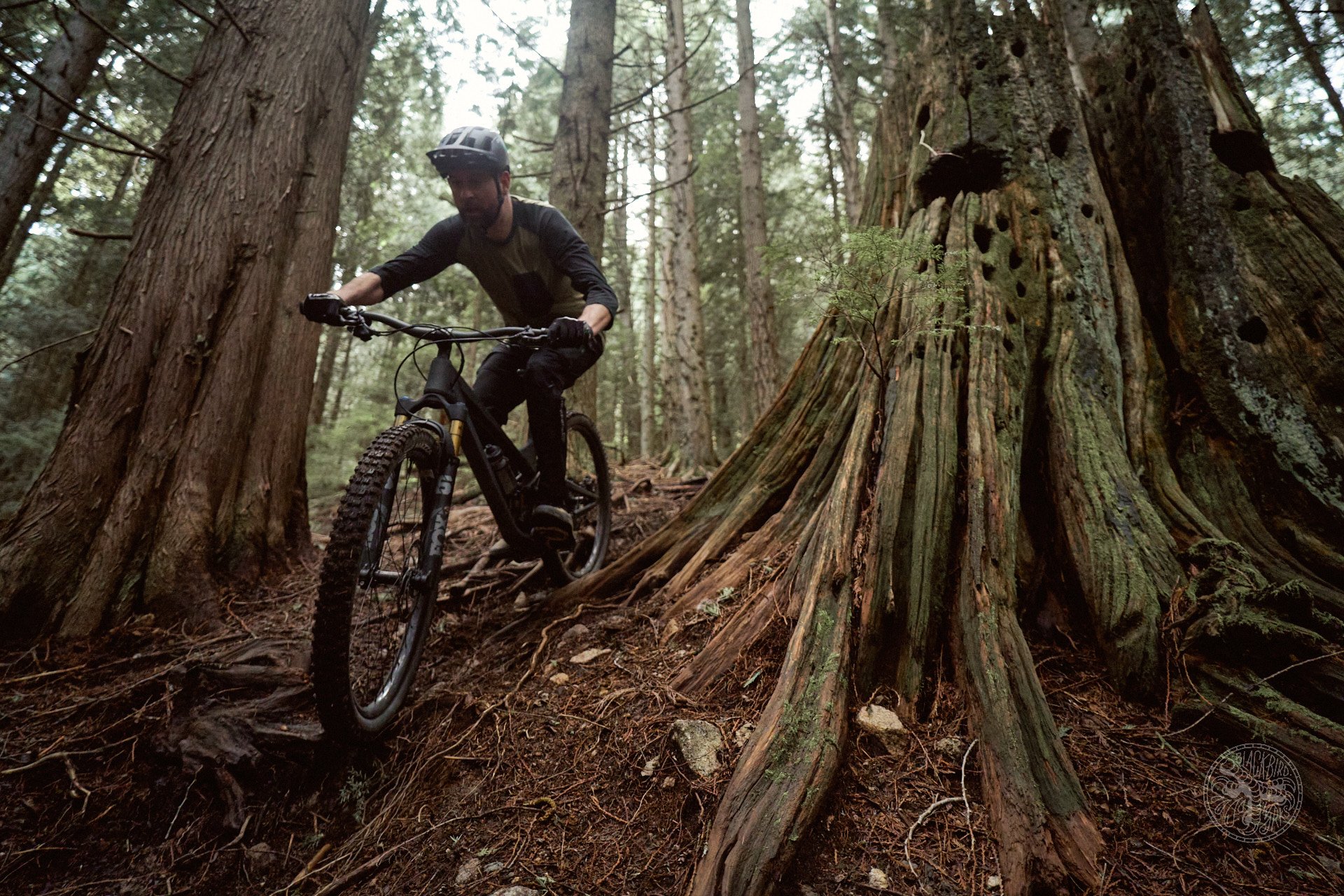
This was a tricky little root and I made quite a few noises as I tried to figure it out.
Setup
Before we get started, we need some disclosure. All was not perfect through the course of this bike test. At some point, the shock started making some squishy noises. These noises went away when I got to my “open everything right up” settings. Once Ryan “the shock destroyer” Walters took possession of the bike, his first reaction was to question why I was riding with a blown shock. As somebody with less experience blowing shocks up (and lots of experience with self doubt), I sort of just worked with what I had within the time constraints of this test. The condition of the shock most likely played a part in how I experienced this bike, but I’ve done my best here to remove that from my judgments.
We Are One is not shy about sharing their expected sag value, but there isn’t much more than that to go on when setting up this bike. Yes, they’re a small company, and yes, this is their first bike, but some guidance on pressure would be really nice and would make it much easier for new owners to get to the right place.
That being said…the guidance that We Are One did provide wasn’t spot on. Unfortunately “body weight + 25-35 psi” wasn’t really the ballpark that I was looking for. I’m at body weight + 55 psi right now and I could probably stand a few more rounds of upward pressure experimentation.
For damping settings, I started with Fox's recommended settings for a given pressure. This sort of worked, but not really. More on that in a minute or so.
In setting up this bike, I often felt like I was chasing two different feelings at the same time. It seemed like there was consistently a bit of travel left in the tank, no matter what I was doing, so I was searching for a way to soften things up and take advantage of the full range of travel. But deviating from the recommended sag, towards something a bit more typical (say 28-30% sag) made the bike feel like it was wallowing, especially while climbing or at low speed.
What’s interesting is that set-up seemed a lot less finicky when heading down the hill. I really didn’t mind descending the bike with sag in that 28-30% range. Hitting that sag knuckle (where they shift from super progressive to less progressive, at sag) seems far more important for climbing than for descending.
So what I learned is that We Are One is serious about their sag recommendation, and you should pay attention to it. This leaves you with a stiff-assed bicycle, and you may find yourself trying to compensate from there. What I did was remove any and all spacers that I could find in the shock (it only came with one installed), and I went way, way lighter across the board on the damping side (from what Fox recommends for the pressure). This left me feeling pretty good about things. I had the lower-end support I needed to keep the bike climbing like it should, and I gained a bit more forgiveness and ability to use most of the travel. There’s probably some more tinkering to be done, but this was certainly a usable set-up. Stiff, but usable. You wind up with what is essentially World Cup DH levels of sag, and that speaks to the intention of this bicycle.
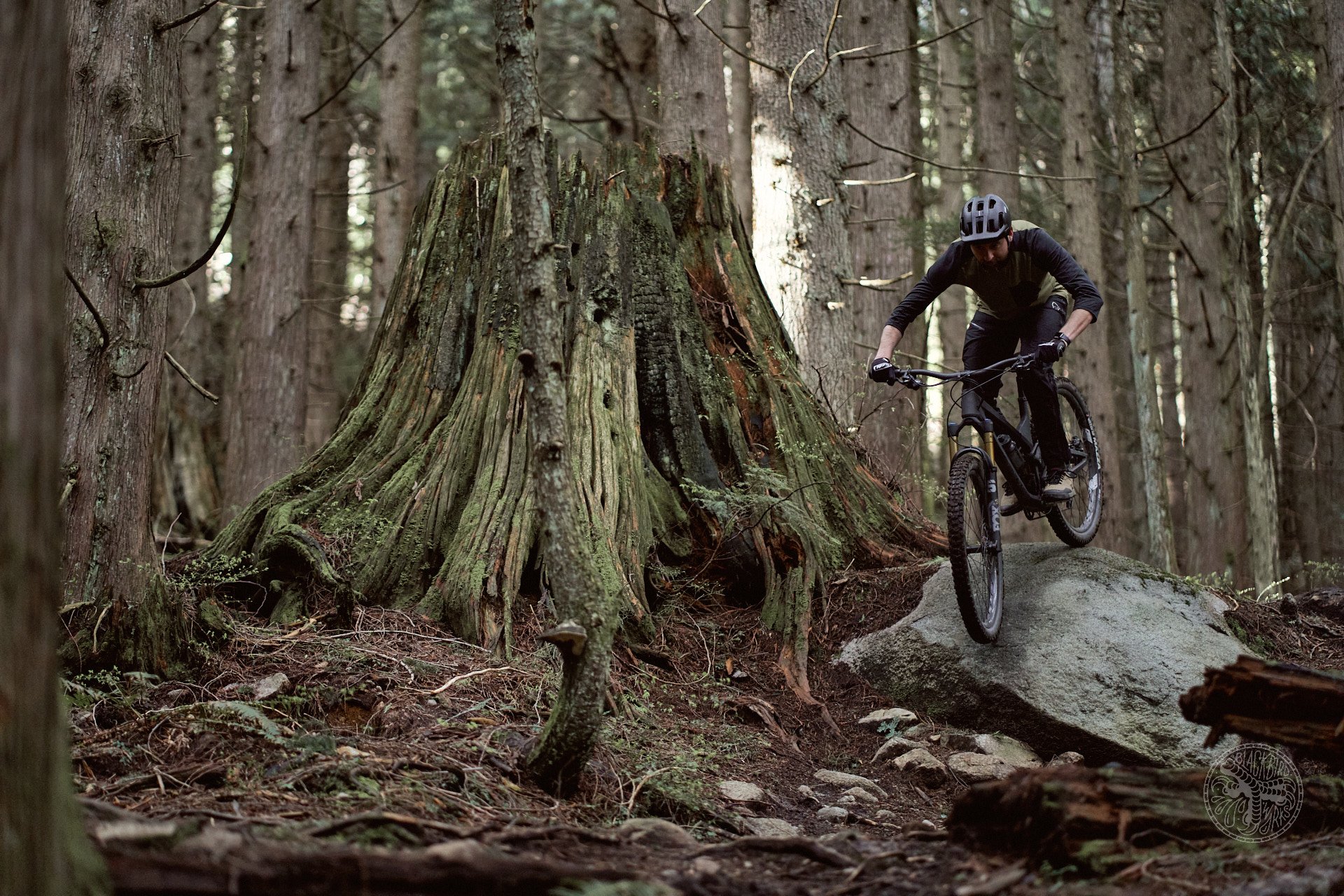
Not the Arrival's specialty, but it does just fine.
Climbing
As mentioned above, it was climbing performance that drove my tuning decisions with the Arrival and how much things improved once I got closer to the recommended sag values, but I feel like this point can’t be stressed enough for potential owners: Do not cheat on your sag values and do not buy this bike if you want a cushy marshmallow.
Once the sag was sorted, it felt like I was climbing a different bike. It became a fast and efficient bicycle that got to the top very quickly. Technical climbing was greatly improved as well, although it doesn’t have quite the technical climbing magic of the Ibis Ripmo.
If this were my bike, I’d very quickly ditch the 32 tooth chainring for something smaller. There are some pretty steep grunts on the North Shore and I find that the 32 tooth with the SRAM 36-42-52 tooth large cogs often left me feeling out of sorts. Yes the spaced over Super Boost rear does give you pretty great chainline in the larger cogs, but I would prefer something that kept me a bit further down the cassette. The two Shimano-equipped bikes that I’m running (also with 32 tooth rings) always felt like they were easier to climb in these scenarios, and I think that’s all down to the 39-45-51 giving a more usable range.
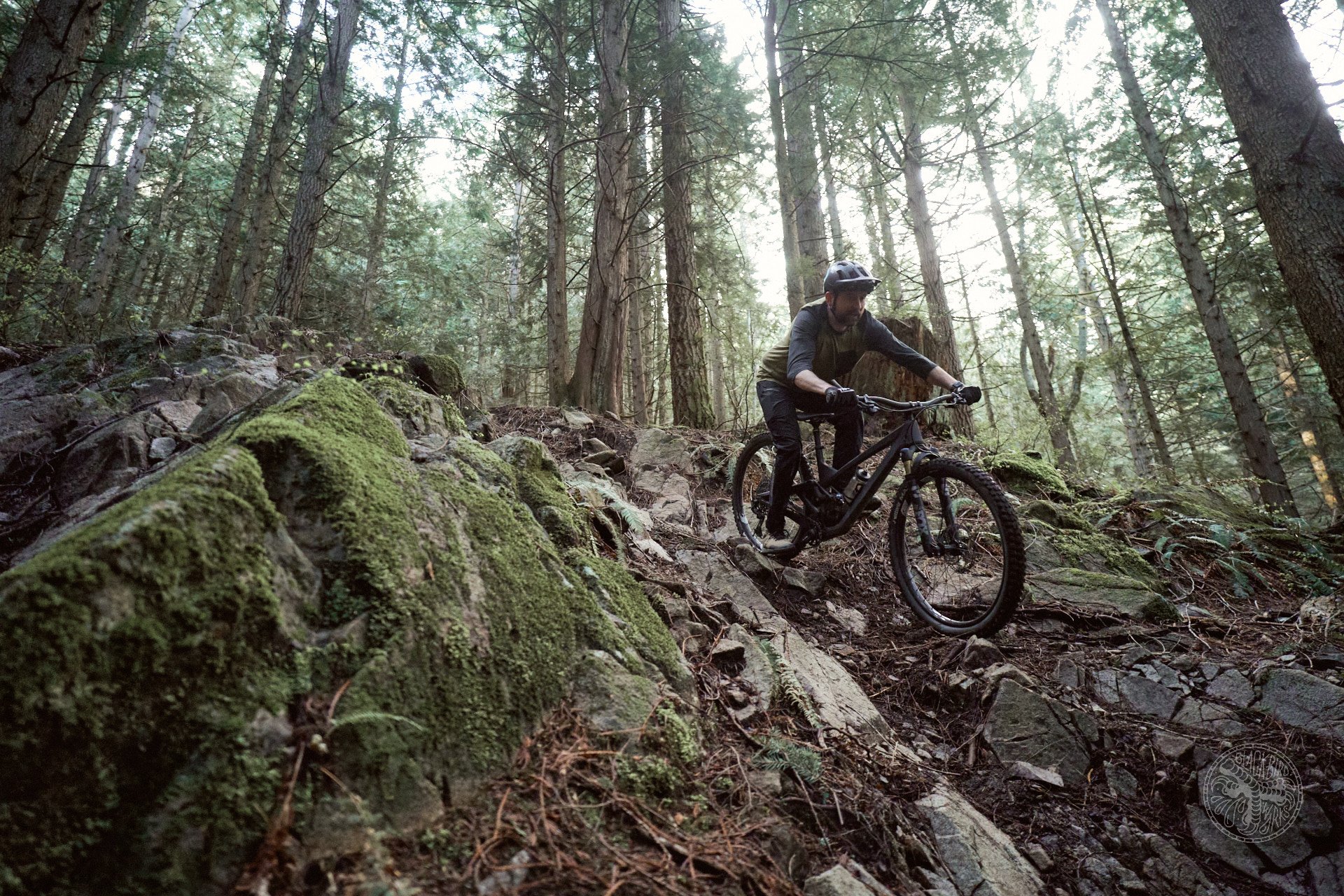
This photo was taken mere minutes before I, yet again, tore my calf muscle. So our choices for photos are somewhat limited.
Descending
During my winter of bike swapping and documentation, I’ve done a pile of back-to-back-to-back testing of some similar (and not so similar) bicycles. No matter what I did, or when I did it, the Arrival was faster.
And not just a little bit faster, but consistently handfuls of seconds faster. I’d ride the Arrival one day and then come back the next on a different bicycle, feel like I absolutely greased the trail, and feel like there was no possible way that I would be slower than the day before…and I was 5 seconds slower. Or more! This is a shockingly quick bicycle that will make you ride faster. Like, scientifically, no bullshit, faster.
How it does that is by being totally poised and controlled. Again, on back-to-back days, I rode the same loop first on the Arrival and next on the Canyon Spectral 29 (a bike that I liked a whole lot) and in anything fast, rough and bumpy it felt like I was just all over the place when I tried to ride at the same pace as the Arrival.
Where the bike made the most sense, though, was when I journeyed home to Kamloops with it (that is my ancestral home, as well as that of the bike). On open trails with higher speed, this bike is untouchable, and the decisions made by We Are One make an incredible amount of sense. The stiff and supportive suspension is just what you want for working high speed corners and pumping through terrain, and that same stiff suspension keeps the bike in shape, but with lots in reserve for plowing into/over/off of large things at high speed.
Bringing the bike back to the North Shore, things are a bit less obvious. For the best and the fastest, it might be just what they are looking for. For others, it can be a bit much on some of our lower speed trails. When things are slow and chonky (a steep chute with a bunch of steps and drops, for example), there isn’t a lot of forgiveness. You’re probably riding that trail faster than you ever have in your life, but you might not be feeling all that great about how things are playing out.
The bike definitely has the ability - it can handle steep, technical gnar like a champ - it’s just that this comes with a bit of an asterisk. It was easy to carve down rock faces with confidence, or pick your way through a challenging move. The bike is capable, it really depends on how much your body can handle.
Really, the Arrival needs to be ridden fast. It needs speed to make those angles work and it needs force for the suspension to move. It’s happiest when you’re trying to squeeze a few seconds out of the trail and it doesn’t make the most sense if you aren’t.
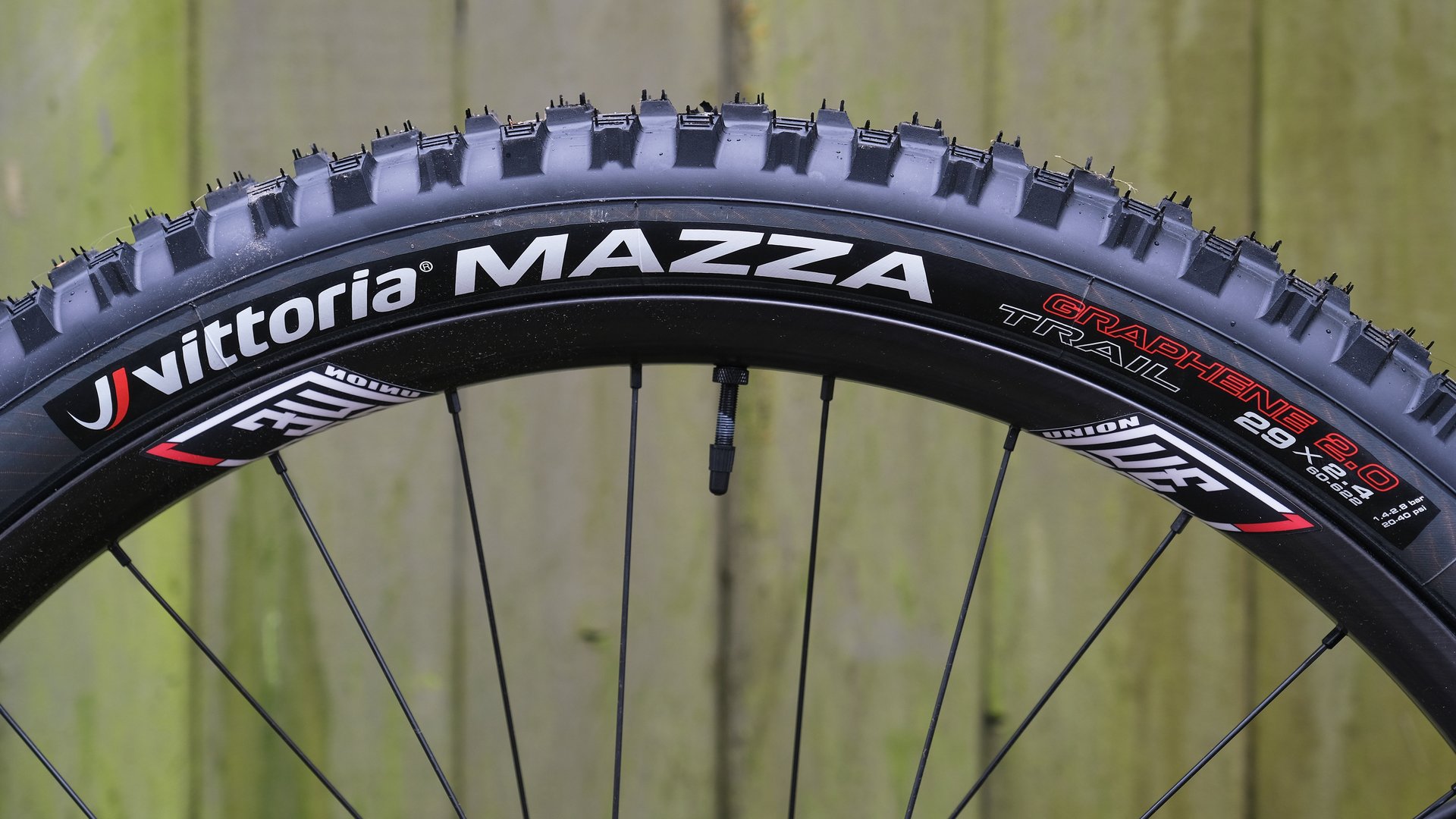
Mazza!
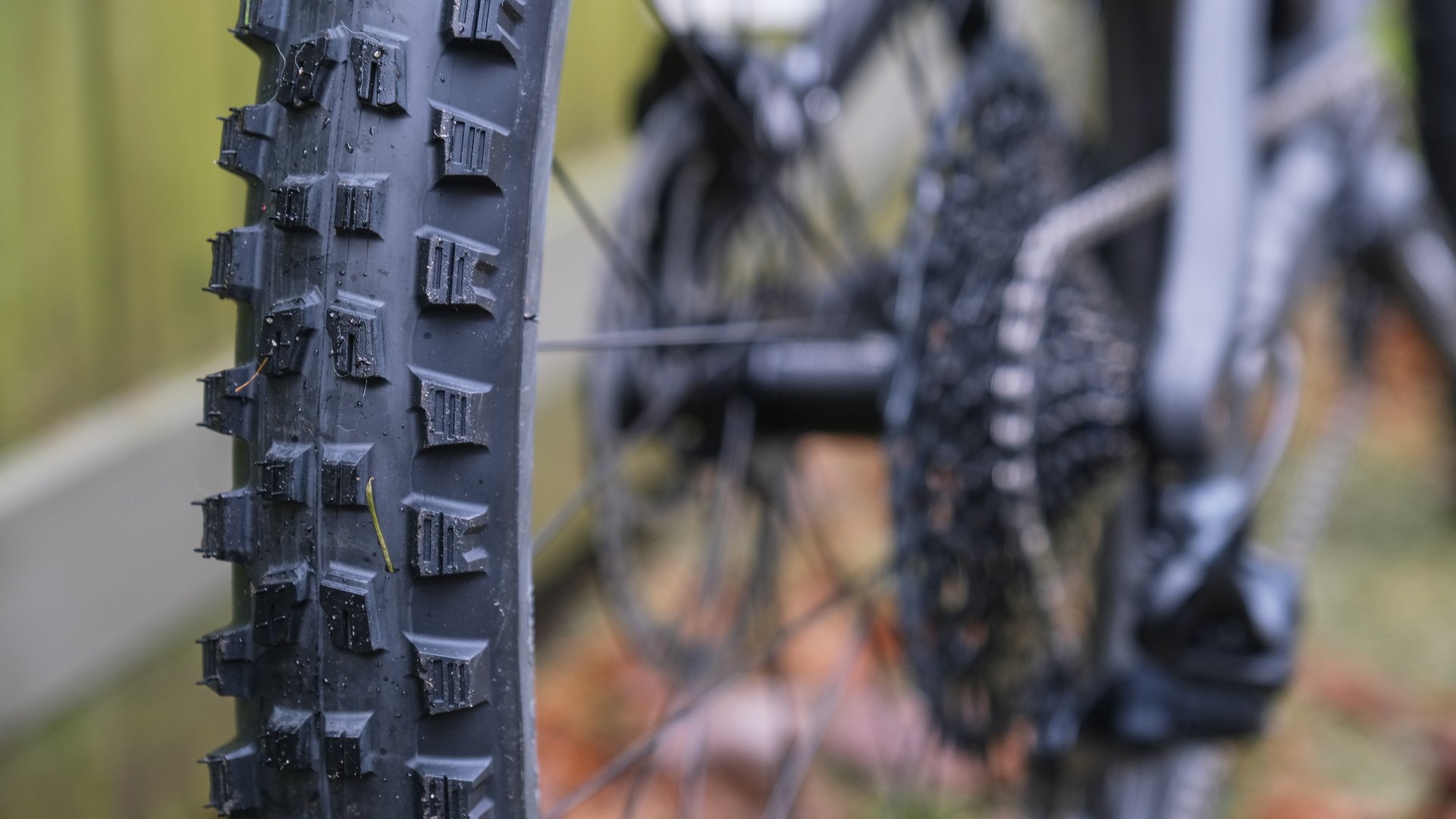
There are some similarities with other tires in the tread.
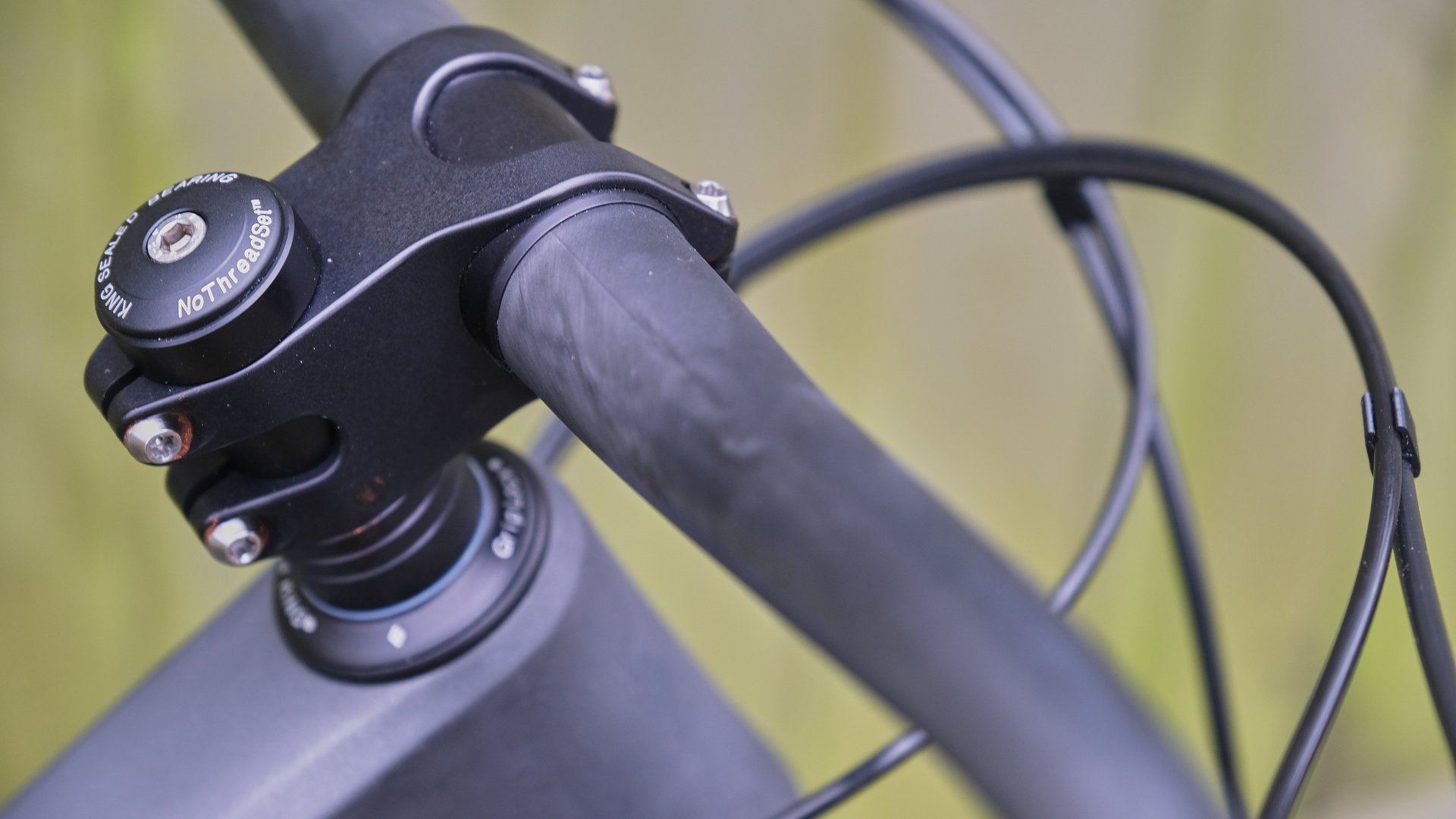
The We Are One stem and bar were unproblematic.
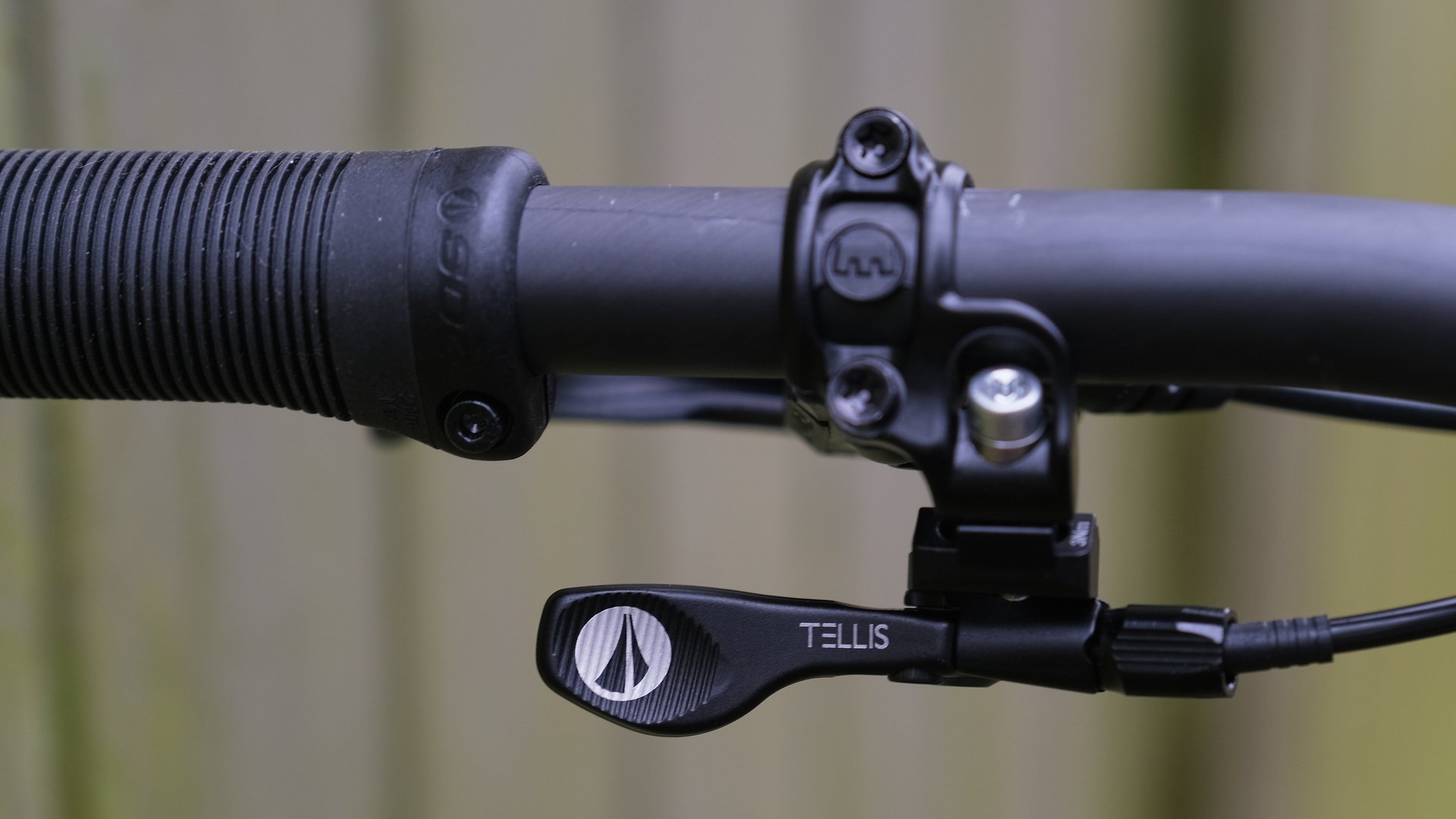
Nothing fancy with the Tellis lever.
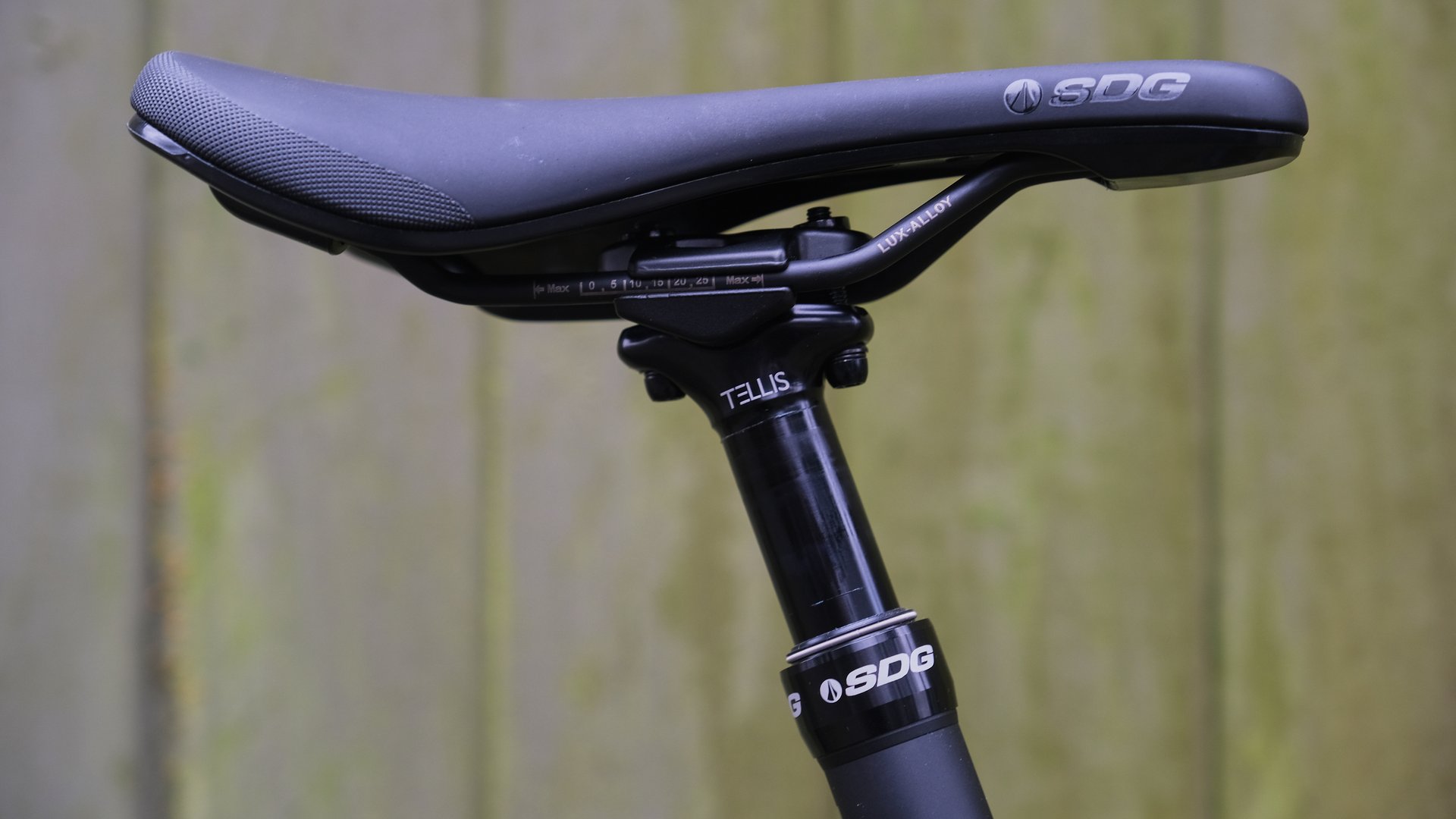
Should you photograph with a dropper slammed? Full height? I choose the middle.
Parts
Somebody in the comments somewhere pointed out that the We Are One offers surprisingly solid value for the roughly 10,000 CAD purchase price. For that, you get We Are One’s solid and dependable wheels, Factory level Fox suspension, a mostly SRAM XO1 drivetrain, and a We Are One cockpit, as well as a made in Canada carbon frame. It’s almost a bargain!
On top of the expected choices, the build kit for the Arrival has a few bits that are eclectic and interesting. Here are some of the surprises.
Tires
The Vittoria Mazza tires are an unusual choice, and seem to have both their fans and detractors. The We Are One came with a 2.4 on the back and a 2.6 up front, both in the trail casing. Tread wise, the Mazza follows current trends and shows some similarity to a Maxxis Minion DHF. Side knobs are a bit chunkier, and there’s a step on the front of the larger center knobs, as well as a few other differences.
The Mazza feels a bit heftier through the sidewall than an EXO, but not quite as much as a DoubleDown. It splits this difference well enough that it might just be what a lot of people are looking for who are looking to step up from an EXO sidewall, but only just. I found it worked pretty well with no inserts, at my typical 20ish winter psi. I clanged rim to rock a few times, but this didn’t cause any challenges from either the rim or the tire.
Traction-wise, I was surprised by these tires. On anything dirt, I had no complaints and felt like I could push the tire as hard as I wanted. On rock and wet wood, it felt like there was less traction compared to a Maxxis’ MaxxTerra compound. These wouldn’t be my tire of choice if facing down a steep wall of slippery roots, but things were fine. Mud performance wasn’t super, either.
Wear was excellent. My mileage wasn’t huge, but the tread barely showed any wear.
Brakes
Ryan “the brake melter” Walters recently posted a comprehensive review of the Magura MT-5 and I mostly agree with everything that he says. Where I disagree is that I think he may have been a little too nice when he spoke about the performance of these brakes in the wet.
Within my first half dozen rides on this bike I had two very wet, very cold rides. On those rides, the first 15-20 seconds of each descent were a frightening experience of terror, where it was like the brakes were brand new and needed to be bedded in. And then the brakes would warm up and things would be back to normal.
I put a bit of energy into researching this topic and came to the conclusion that there must be some sort of magical, wet weather only contamination of these pads. I even went so far as to add some Galfer pads into a shopping cart, but never pulled the trigger. The solution for me was to not ride the bike in the wet.
After reading Ryan’s review, it seems apparent that there is something else going on. Maybe there is something wrong with these pads? Maybe not? Unless you never ride in the rain, I would budget some money for new pads right out of the gate.
SDG Dropper
The SDG was another surprising choice for this bike. It’s a simple, cartridge-based dropper post, like many others. Lever action is very, very light, and the post goes up and down without any challenges. No issues, no complaints.
King Headset
When’s the last time you saw a King headset spec’d stock on a bike? Beautiful stuff.
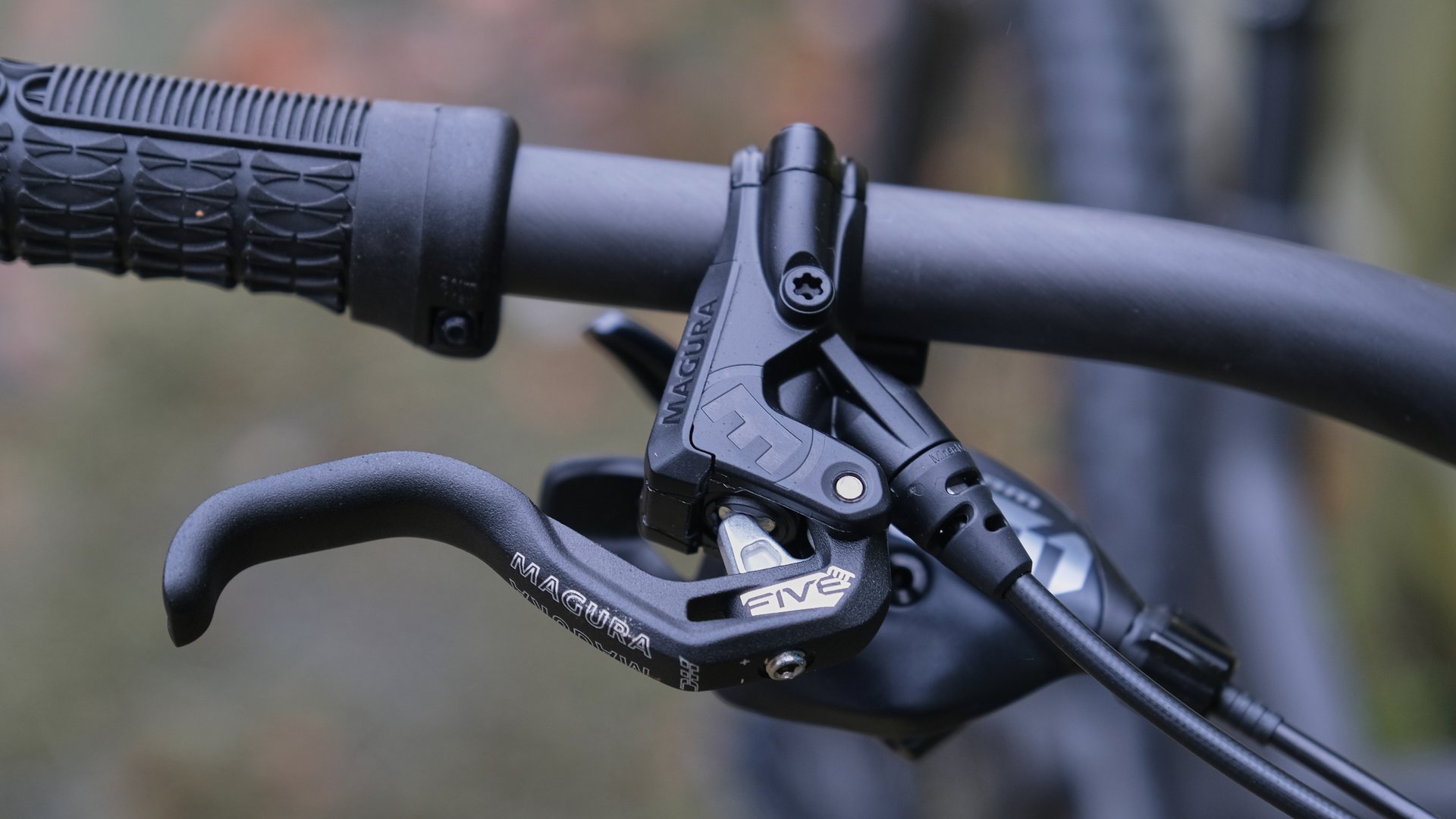
Complaints about Magura master cylinders and levers seem fairly prevalent, but these took some pretty serious whacks and felt nice in my hands.
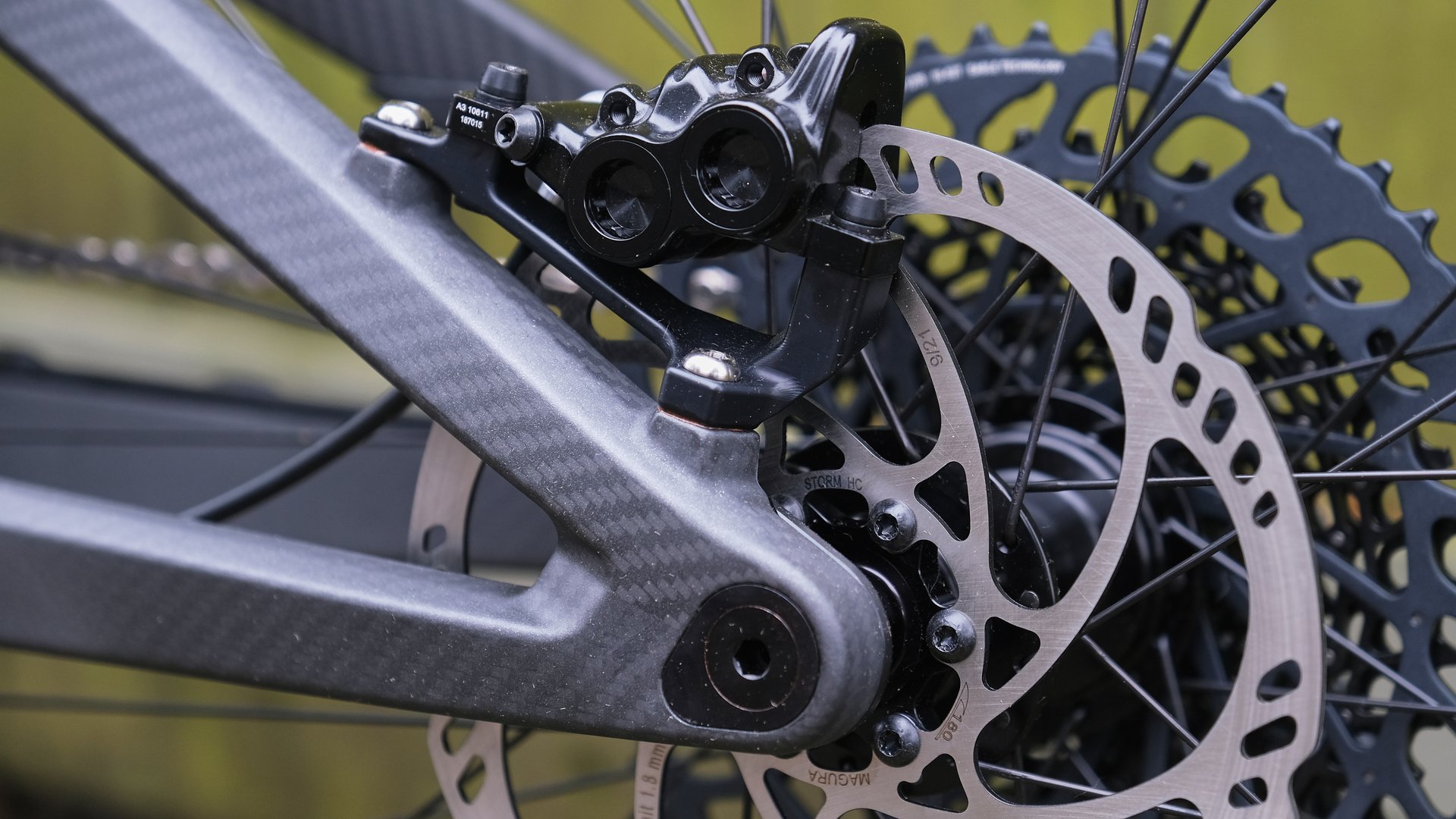
Here we see a fairly standard disc and caliper. Problematic pads reside somewhere inside.
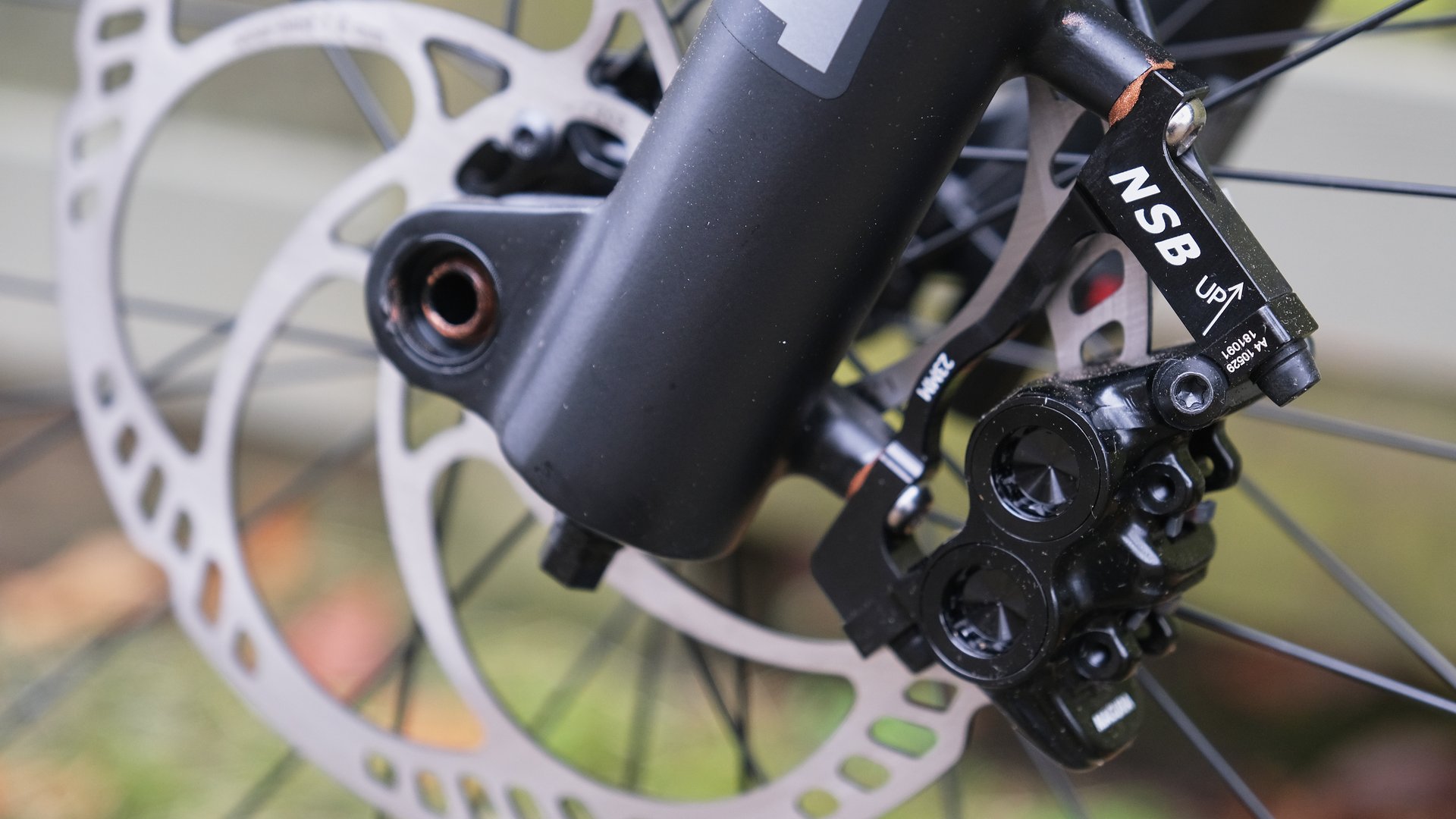
An NSB adapter to match the fancy custom one on the rear.
Conclusion
There was a time when bicycles were of a place, and framebuilders used miniscule differences to set their designs apart, and thus determine the use of that bicycle. You had the “BC Bike,” with a sloping top tube and a half a degree slacker head angle. You had the “East Coast Bike,” with a slightly higher bottom bracket. And you had the “Norba Bike,” which was everything else. In the years since, we’ve developed a means of hyper-categorization that has replaced any sort of geographical representation. Who needs a BC bike when you have Trail, Enduro, and All-Mountain to choose from for your British Columbia-based adventures?
It feels like We Are One may be taking us back to the old ways. The Arrival is such a perfect encapsulation of Kamloops, I don’t know what else to call it besides a “Kamloops bike.” You probably couldn’t wish for anything better if your trails are steep, rowdy and fast, and it takes that sort of terrain to unleash its full potential.
The good news is that these days, Kamloops riding is a fairly major template for the world of mountain biking, so there are many places where the Arrival is going to work really well. “Fast” should probably be the most important of those criteria to consider (have I mentioned that yet?), as the We Are One only feels right if you’re pushing things out into the margins. It doesn’t like to go slow and it has no problem letting you know that it isn’t happy while doing so.
It sometimes felt like a bit of a waste riding this bike on the North Shore. It was never slow, and consistently saw me laying waste to previous best times down numerous trails. It’s a confidence-inspiring bicycle that can take on the worst that you can dish up. Even so, it sometimes felt like it did these things at the expense of my body. It would not be my first choice of bicycle for anything slow and janky, or exceedingly chunky and rough. I sometimes would finish up a ride and wonder how it was possible for something so beautiful to treat me so poorly.
I’m sure that We Are One would be the first to admit that this might not be the right bicycle for everyone. This is a bike for those at the top end, to ride at the limit. This is a bike for those that need to go as fast as possible, and aren’t too worried about any sort of side effects. Others may struggle to keep up, or to use all of the capabilities, and might be better served by a slightly duller tool. Or a coil shock. I’d be curious to try this bike with a coil shock.
It’s also a bike for the long haul, and I appreciate listening to Dustin Adam’s talk about his intentions for this bike. This is intended to be something of a forever bike. It’s built with longevity in mind. Within that context, this bicycle makes a lot more sense. The cost of bicycles is becoming somewhat absurd, to the point where we no longer flinch at an MSRP north of $10,000. If I were to spend that much on a bicycle, value-wise this one would probably come the closest to making some sort of sense. Not only are you getting some exclusivity for that price, but you’re getting a bike that the manufacturer fully intends to support for the long haul. One could argue that owning this bike may make the owner less likely to feel that two-year urge to upgrade. Looking at it that way, you’d kind of be silly not to buy one.
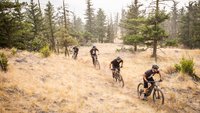
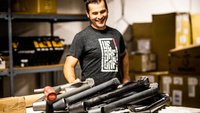
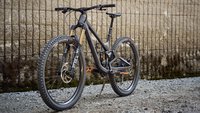
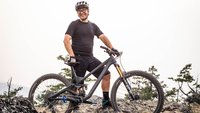
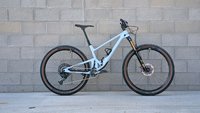

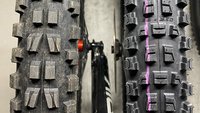

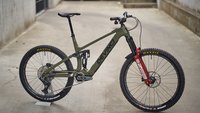
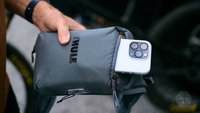
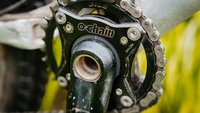
Comments
thaaad
3 years, 1 month ago
I'd be interested in how much the blown shock contributed to the impressions of the bike. No disrespect to Dave but I am highly skeptical that someone could get an accurate impression of how a bike rode with a blown shock, no matter how objective one was trying to be.
Reply
Dave Tolnai
3 years, 1 month ago
My first response when I figured this out was to just scrap the whole thing. I got a few opinions from people that I trusted, and after that I was confident enough in what I'd done to share my experience but to include the disclaimer. It's totally within your right to read that disclaimer and decide to completely discount what I've said. I felt confident enough to write this, submit it and include my name on it. It's not perfect, but bike reviews seldom are.
Reply
thaaad
3 years, 1 month ago
In no world would I endorse discounting your experiences or what you said in your review so I apologize if that comment came across that way. Am just musing mostly, not trying to undermine your opinion at all.
Shock performance is just such a massive part of how an FS bike rides (goes wihtout saying) that even a perfectly functioning shock that is just set up poorly could greatly colour our experience on a bike.
Either way I still enjoyed the write up :)
Reply
earle.b
3 years, 1 month ago
It's not inconceivable that Dave could get an accurate impression of the ride.
In order of suspension importance.
1)Kinematics
2)Friction
3)Spring rate
4) Damping.
So the frame itself covers #1, they don't have any funky inflections in the LR curve. The shock was new, so assuming Fox didn't completely screw it up a fresh shock would have low friction. Dave played with air pressure and ran the recommended sag and experimented with more sag, air shock allowing him get it right vs limited coil options.
Last is the blown damping on the shock. Was it the rebound circuit or compression? I think more info other than "blown shock" would shed more light on it. If we break #4 down further I think a blown rebound circuit is going to have greater impact on feel than a blown compression circuit. Maybe Ryan can chime in with more on what was messed up in the shock?
Reply
thaaad
3 years, 1 month ago
In terms of blown shocks a massive majority of the time people are (knowingly or unknowingly) referring to 1 of 2 things which are loss of oil from the damper, or air/nitrogen ingress in to the oil volume.
Neither of these are independent to rebound or compression. If you lose oil or you have air in your oil this is going to affect both compression and rebound. If you have no oil, or your oil volume is say 50% air due to both oil loss and air ingress then your damping and compression are both going to function incorrectly, objectively.
See this video below for an example of how most twin tube shocks function.
https://vimeo.com/130459969
The perception of the ride is also highly dependent on the severity of the failure as well. If it is just a small amount of oil loss or air ingress you will likely perceive very little change but if it is a ton of air in the damper or complete oil loss then you're looking at a potential loss of 100% of both compression and rebound damping which of course would severely impact your ride feel to the point of being potentially dangerous.
If your shock is not functioning as it should due to a high volume of air in your oil then you might have the impression of the bike being "lively" since the damper is providing very little resistance in both directions and will feel very soft and active.
I do not personally agree that the damping is as low down the priority list as your post makes it out to be, but that's a subjective opinion. I am just one guy and I am comfortable being proven wrong.
I do think there is still value in the review and I do agree that you can definitely feel a bike out with a blown shock it's just unfortunate that the impressions were (potentially) affected by an improperly functioning shock.
TLDR: Edit - I mostly agree with you, but I think it's more nuanced than proposed. Aaaaand my statements are presented entirely on the idea that this is a run of the mill seal failure (which is most likely) rather than something catastrophic.
Reply
Ryan Walters
3 years, 1 month ago
In this case, “blown” means a very emulsified damper - most likely nitrogen from the IFP chamber. I’ve ridden plenty of shocks in this state (never by choice, but ya gotta do sometimes), and while I wouldn’t want to try and race, or do big moves on a shock like this, it certainly is “rideable”, and doesn’t take too much away from the characteristics of the bike. The valves seemed all intact, so after a few cycles of suspension, the gas bubbles mix with the oil and damping gets more consistent. It’s not ideal, but also not the end of the world.
After my one and only ride on the Arrival, I pretty much agree with everything Dave said about it. It’s a very sporty bike, likes to go fast all the time, and isn’t a plow bike. Bring big skills, and this bike is unstoppable.
Reply
thaaad
3 years, 1 month ago
So that's exactly what I was referring to when I was mentioning air / nitro ingress but wasn't sure how technical we wanted to get in the comment section. Failed IFP seals are easily one of the most common failures we saw in rear suspension when I was a tech.
Glad to hear that it wasn't as bad as it could have been and that you're confident in your assessment of the bike! I really like those bikes so I'm glad to hear that it was a killer ride regardless of the blown shock :)
Reply
Mark
3 years, 1 month ago
I think the best part of this review (which is indicative of nsmb reviews in general) is that the reviewer tells the reader without any bs or hyperbole just what this bike is for and who it is best suited to.
> This is a bike for those at the top end, to ride at the limit. This is a bike for those that need to go as fast as possible, and aren’t too worried about any sort of side effects. Others may struggle to keep up, or to use all of the capabilities, and might be better served by a slightly duller tool.
Reply
YDiv
3 years, 1 month ago
Did Andrew put this bike together?? There's anti-seize everywhere haha
Reply
Dave Tolnai
3 years, 1 month ago
So much anti-seize! I don't know if that is standard, or journalist bike specific, but it seemed like a lot of care was put into the assembly.
Reply
Justin White
3 years, 1 month ago
The use of anti-seize implies care put into the procedure (assuming its presence is due to WAO's assembly procedure), but that it is visible everywhere leads me to think it was put together in a bit of a hurry with maybe a bit less care than the procedure intends.
I know it can be a pain to clean thoroughly, as I also use anti-seize pretty liberally (Ti stem bolts, shock mounts, brake mounts, and chainring bolts), but I also take the time to clean it up a bit so it doesn't end up everywhere else on the bike, like the sides of the stem.
Reply
Dave Smith
3 years, 1 month ago
I'm in in much agreement after 2 months of riding. My take-aways would be that this is a snappy cornering beast and I would say this bike deserves bigger rotors for the intended speed and confidence that the bike induces.
I would also say that I love the lack of branding and stealthy nature of the lines and angularity of the curves.
Reply
luisgutierod
3 years, 1 month ago
So, coil her up and shoot for 20-ish% sag?
I really want to put my head around the low sag thing.. and tracking.. and the high LR… may be cascade guys will come up with lower LR link hahaha. Beautiful bike !
Reply
Tjaard Breeuwer
3 years, 1 month ago
Yeah, that’s what I was thinking, if you were struggling to get full travel, and wanted a bit more plushness at slower speeds, that sounds like a good candidate for a coil shock.
Any way, nice review, and a interesting bike.
Reply
Jerry Willows
3 years, 1 month ago
the WAO 170mm bike has a recommendation of 30% sag so it's going to be more of a plow/plush bike.
Reply
Cam McRae
3 years, 1 month ago
I’m hoping to have one built up shortly. I have the links, just need to track down shock hardware and I’m there.
Reply
Speeder1
3 years, 1 month ago
Cam, have you ridden this bike? How does it compare to the SB150, which, to me, gets better the harder I ride it.
Nice write up, Mr. Tolnai. Your description of this bike reminds me of an e36 BMW M3 I had the pleasure of owning for a while. It was harsh around town and in traffic, which is most of the driving that one does living in a metropolitan area. It came alive when driven in spite and with purpose, however, and its design and execution were then greatly appreciated.
Reply
Cam McRae
3 years, 1 month ago
At this moment I have everything I need... except the correct shock hardware for the rear shock. Comparing the SB150 to the 152mm travel Arrival, they are very different indeed. I expect the kinematics and more generous recommended sag of the 170 model will narrow that gap but we'll have to see.
Reply
Slinger
3 years, 1 month ago
Oh damn! How'd you manage to get your hands on those?? I've been bugging them since last year, lol
Reply
Cam McRae
3 years, 1 month ago
Squeaky wheel I guess.
I have two rides in and the bikes are incredibly different, but with some obvious similarities resulting from the dual link design. As you might expect, you can put the Arrival 170 into some much nastier situations and it asks; "is that all you've got?"
More to come but so far I'm very excited about where this bike might take me.
Reply
Carl Hall-Gallus
3 years, 1 month ago
Can’t wait to hear how the 170mm link works with a coil shock as this is something I’m considering trying out on my arrival.
Reply
WalrusRider
3 years, 1 month ago
It certainly seems unusual to me that they recommend 20% sag on this bike. Riders much over 200lbs might run into some problems because of the high leverage. With that said, I'd love to swing a leg over one of these and see how it rides.
Reply
Timer
3 years, 1 month ago
There’s always a compromise involved when choosing leverage ratios. While heavy riders might struggle with the required pressures on the Arrival, low leverage bikes can be problematic for light riders, especially with air shocks.
Reply
T-mack
3 years, 1 month ago
Im 230 pounds and have my psi set at 295. I have had no issues thus far. My 2020 Enduro was set at 270psi so not too far off.
Reply
Phil Szczepaniak
3 years, 1 month ago
This review is spot on. After hopping on this bike, I've gravitated to faster local trails in Squamish that I would seldom do before on my Megatower (Credit Line to be specific). It definitely rewards speed! I've been on a coil shock since day one and have to say it's velcro both up and down.
Reply
fartymarty
3 years, 1 month ago
Are you still running the recommended sag with the coil? Also what coil shock are you running?
Reply
Phil Szczepaniak
3 years, 1 month ago
Yes I'm at the high end of the optimal sag, 24%. However I'm on an EXT Storia, which has a pretty firm tune so it sits a bit higher in its travel. 500lb spring (170lb rider). It's damn near perfect.
Reply
Vincent66
3 years, 1 month ago
Very interesting review. As many readers, i like the overall tone of the article and the actual content, not just WEA website copy-paste. Thank you.
I would be interested in a comparison with a Knolly Chilcotin 151.
Reply
IslandLife
3 years, 1 month ago
I just moved from a Chilcotin 159 to the Fugitive 138 (but with a 160mm fork). The suspension design sounds a lot like my Fugitive. Very supportive platform paired with lots of progression so it's quite supple off the top and around sag, but doesn't easily give up the deeper travel easily. Which for me, I like... I really like the supportive nature of the bike for climbing, pumping, racing and keeping speed... but with the progression you don't have to worry about charging into big hits, drops and gnarly stuff as the design "has your back". Paired with a good coil, it's very good. The platform and progression allows you wind off much of the high and low speed damping and just let the shock and suspension design do the work... feels great.
My Chilcotin was a different beast... more of a traditional "enduro bike" feel. Still some good progression baked into the design (worked well with a coil), but not as much as the Fugitive and it sounds like the Arrival has.. but still has that Knolly magic feeling rear end. Of course I was on the 159 version... I'd assume the 151 would feel a little more supportive than the 159 or, of course, the 167. So probably depends on what and how you like to ride.
Reply
Vincent66
3 years, 1 month ago
Thanks man !
I was thinking of using a 151 with a coil shock.
It might get closer to the Arrival than my actual 1st gen Warden on the way up.
While still offering a more traditional "enduro-freeride" feel on the way down.
For a fraction of the price too ...
Reply
IslandLife
3 years, 1 month ago
Oh ya, if you're comparing to the first gen Warden, you'll be very pleasantly surprised by the reworked 4x4... especially the support and climbing platform. But somehow they still haven't lost that magic Knolly ability to make the big chunk and hits disappear... such fun bikes!
Reply
Kos
3 years, 1 month ago
Sounds wicked fast.
Superboost, argh.
Reply
Ryan Walters
3 years, 1 month ago
Don't necessarily hate on the Superboost on this bike - they combine a Superboost rear end with a Boost BB spindle to achieve a better chainline for the climbing gears. And yes - it's noticeable.
Apparently, this leads to more friction losses in the smaller cogs - but who cares. This isn't an XC bike, and any rider on this bike is going to spend the vast majority of their pedaling input in the biggest cogs anyway.
What WAO have done with the chainline on this bike is kinda brilliant.
Reply
AndrewR
3 years, 1 month ago
It is brilliant and I have been recommending the use of non boost chain rings on boost bikes for most riders in the Sea to Sky for several years. It optimises the chain line for the gears that one uses for the majority of the ride time (and the most torque into the system) versus the perfect chain line for the top level racer.
The average (good) rider is not pedalling to go faster when travelling in the 25 - 35 kmph range on downhill technical single track. They are pumping and using an occasional half crank to clear a trail obstacle or allow the leg muscles to feel a different position. Racers, a different breed with different requirements. Unfortunately the 520% cassette and boost chain line are optimised for a bit of a 'do everything' situation.
Also park the ego and pick a chain ring that allows the alloy 51/52 to be an emergency bail out gear rather than something that is in regular use.
Common sense and savvy use of the mountain bike maintenance dollar as far as I am concerned.
Reply
IslandLife
3 years, 1 month ago
I'm about to pull the trigger on this now... but was just reading the Wolftooth description about why chainlines are where they are... and they say that if you adjust the chainline (inboard), there is potential for the chain to constantly lightly tag the next cog in a 12 speed set-up when using the smallest cogs. Ever experience or hear about that?
Reply
Justin White
3 years, 1 month ago
Yes and no.
I have an effectively non-Boost crank chainline with a Boost rear hub (details below), and when pedaling backwards on the 10t, I can feel the chain catching very slightly on next bigger cog. But, when actually pedaling forward on the 10t I haven't noticed anything. I think the tension on the chain helps straighten it enough to not catch. It might be rubbing slightly, but I'm not putting down max watts on that 10t often enough to notice any adverse effects.
Details: GX Eagle 10-50t cassette and RaceFace "Boost" direct-mount crank (though the Boost-ness is really decided by the ring or spider on a DM setup) with a 2x bashring-compatible spider on it. The 2x setup puts the "middle" spot (inner spot empty, outer spot has a bashring) at ~53mm, and I then shift it in-board by ~3mm with chainring spacers, and also shifted the whole crank ~1mm inboard via the spindle spacers Raceface provides for this purpose. This brings the chainring pretty close to a non-Boost 49mm 1x chainline.
Reply
IslandLife
3 years, 1 month ago
Thanks for the info... was thinking kinda the same, don't really mind full performance being a tiny bit limited on those last couple of cogs. Definitely more of a winch and plunge rider. Would be surprised if I have even pedaled in my 10t this year, ha!
That's good info, I'm on a SRAM superboost setup, GX Eagle 10-52... going to replace the 0mm offset SRAM ring with an NSB boost (3mm offset) ring.
Timer
3 years, 1 month ago
Couldn’t you get a very similar chain line simply by using a non-boost chainring/crank with a boost rear hub?
Reply
Mammal
3 years, 1 month ago
If there's enough space to clear the chain stay. My current bike, I'd need to downsize the ring teeth to clear a non-boost ring.
Reply
Tjaard Breeuwer
3 years, 1 month ago
I have done that very thing on 2 bikes
Reply
taprider
3 years, 1 month ago
Did Dave still blow away his previous best times with a blown shock?
Reply
cheapondirt
3 years, 1 month ago
So it's the Dodge Viper of mountain bikes, but with build quality... Nice.
Reply
Timer
3 years, 1 month ago
What a beautiful bike, even if it wouldn’t suit my riding style (or skill level) at all.
I’m a bit surprised by the tyre choice, though. On a bike this capable, built for speed, and made in (and for) the PNW, I would have expected heavier casings and much stickier rubber. Maybe the tyre spec was influenced by the supply chain issues?
Reply
cheapondirt
3 years, 1 month ago
If I recall correctly from other posts, you're not from Canada, right? Kamloops isn't what we think of as "typical PNW" at all. Though it's just a 4 hr drive from Vancouver, it gets much less rain.
Reply
IslandLife
3 years, 1 month ago
Kamloops is not the PNW... dry dusty desert hardpack. Lots of hard-pan bermy flow mixed with chunky, crumbly, shale-y rock which can be steep and gnarly at times.
Reply
Timer
3 years, 1 month ago
Good point. While I did live in Vancouver for a while, I never got to visit Kamloops and didn't know it was that dry. In such terrain Vittorias, with their good tread design but hard rubber, make a lot of sense.
Reply
Hugo Williamson
3 years, 1 month ago
Looks very much akin to the Giant Maestro linkage, the detail of course in the exact pivot location.
There are a few companies that are started by Ex WC DHers, Dan Critchlow @ Burgtec, the Atherton family in the UK.
Reply
Cooper Quinn
3 years, 1 month ago
Its a bit of a stretch with the Athertons, no? Robot Bike Co existed years before their involvement.
I'd argue Cesar Rojo fits the bill with UNNO, though.
Reply
fartymarty
3 years, 1 month ago
Dave - great review and a real looker of a bike. You mentioned a blown rear shock. Was the bike reviewed prior to you getting it? If so you would think WAO would make sure everything was working fine before sending it off for review.
Out of interest how tall are you? Also what is the fork travel? - Edit : I've just read elsewhere that it's 160mm.
Thanks, m
Reply
Dave Tolnai
3 years, 1 month ago
Bike was brand new, unridden when it showed up. Either that, or somebody did the deepest clean that I've ever seen and managed to re-attach all the little nubbies onto the tires.
Reply
fartymarty
3 years, 1 month ago
That's strange WAO didn't check the bike prior to sending it over. I would have expected them to have the shock rebuilt and set up for your weight.
I completely understand how you missed it given the lower amount of sag and high leverage ratio. A few psi either way could make a massive difference. Add in volume spacers and it would be very easy to get it set up badly.
Reply
IslandLife
3 years, 1 month ago
I'm assumed it blew during his testing? He mentioned "At some point, the shock started making some squishy noises"... that was probably just after it blew.
Reply
Carl Hall-Gallus
3 years, 1 month ago
For what it’s worth I had the exact same experience with my arrival. Shock was getting louder within the first 5 rides and a damper bleed solved the issue. I also removed a spacer from the shock in the hopes of using more of the travel.
Reply
4Runner1
3 years, 1 month ago
Great review. While I’m certainly in no rush to replace my Ripmo V2, I have had my eye on this bike. After reading this, I’ll stop considering it as my next ride.
I like fast but spend a lot of time on slower, chunkier stuff. Add in my 50 year old body and it looks like this isn’t the bike for me.
Plus, I’m not the rider that spends most time in the larger cogs and so appreciate a bike that performs nicely at not quite warp speeds.
This WAO is beautiful but maybe the eventual Ripmo V3 will be more to my style.
Reply
Dave Tolnai
3 years, 1 month ago
The Ripmo AF was one of the other bikes that I rode while riding this, and these bikes are pretty much on opposite ends of the spectrum. If you like the Ripmo, this thing is going to ride a lot differently.
That's not to say you'll hate it! It was sort of a spectrum with the Ripmo being the softest , the Spetral 29 being a fair bit firmer, and then the We Are One taking things even further. I was often surprised by how well each of these bikes did the things that they maybe weren't supposed to, but there are situations where I would absolutely want one of them over the other.
Reply
4Runner1
3 years, 1 month ago
Good to know! Appreciate you responding with your experience.
Reply
Heinous
3 years, 1 month ago
This is gold, the Ripmo V2, Arrival, and maybe the 130LR seem like they’re not miles apart on paper, all coil (and Push) compatible. I’m really leaning towards an Arrival right now.
Reply
Andrew Collins
3 years, 1 month ago
Shock and fork choice can have a huge impact on how a bike 'feels'. I've got a Banshee Rune V2 (late model) and an alloy Canfield Balance. Originally the Banshee Rune had a fox 36 and Float X2, the Balance had DVO Diamond and a T3.
I found Rune too stiff and the Balance a bit of a marshmallow. Swapping the fork and shock between the 2 bikes transformed them. The bikes still ride very differently, but now the shortcomings have been covered up, and I can enjoy their strengths without any niggling concerns.
Reply
Vik Banerjee
3 years, 1 month ago
Looks like a nice bike. Also sounds like the suspension could appeal to us hardtail fans for whom a more supportive rear suspension platform would still feel "plush" compared to a rigid back end.
Reply
ohio
3 years, 1 month ago
It's just so pretty, I want to want it.
Not sure the riding style suits me, though (and I'm not in the market anyway until my Spec Enduro is broken or worn out)... I can't imagine at WAO's scale they have any kind of demo program, do they? With such a different take on the compression curve, it sounds like the sort of thing you have to ride to understand.
Reply
Justin White
3 years, 1 month ago
Really great that they put so many numbers right out there for everyone to see. Maybe not everyone knows what they mean or cares about them, but that's was reviews like this are for: "do not buy this bike if you want a cushy marshmallow" and "only feels right if you’re pushing things out into the margins [of fast]". But for those that have some ideas of what the numbers can imply, it's really cool to have them available as well.
Reply
pedalhound
3 years, 1 month ago
My buddy went from a Ripmo to an Arrival and he is really loving it so far! I just got a Banshee Prime and we while they are quite different bikes, the linkage looks pretty close to the KS2 design, even down to the lower sag...but the Prime has way lower leverage ratio (same size shock for 135mm travel) and being over 200lbs this matters to me...also love the tall stack height on the Prime. I gotta say, the Arrival is a hella sexy bike, looking forward to seeing what WR1 does in the future!
Reply
Franky
3 years, 1 month ago
Really hope the frame only option on this is reasonably priced. This could split the difference between my trail and Enduro bikes and replace them both. I think I have perfect parts to just swap over (except for the stupid super boost rear, why not go regular boost wheel with a non-boost crankset if they wanted a better chain-line??)
Reply
Wangchung
3 years ago
people are going slow on 150mm rear travel bikes?
weird.
Reply
Cam McRae
3 years ago
Come visit the North Shore and we'll show you what we mean by slow. Cheers!
Here's an example:
Reply
handsomedan
2 years, 11 months ago
Curious to know when the short travel link will be reviewed?
Reply
Will Poindexter
2 years, 9 months ago
Great review and super consistent with my past few months of riding the Arrival. I am still struggling with shock setup even with sag set appropriately (235 psi for 165ish lbs) but plan to remove the rear spacer and open the compression a bit. Also put an extra token in the fork to balance out the feel - will remove that too. Will see how that goes else am going to sell the frameset. I like the looks of the bike better than I like riding it.
Reply
Please log in to leave a comment.